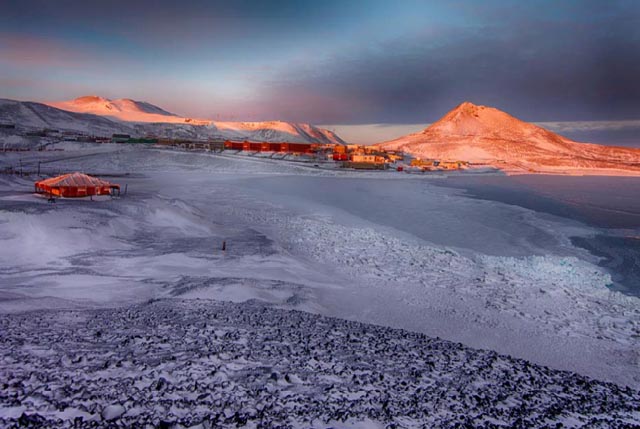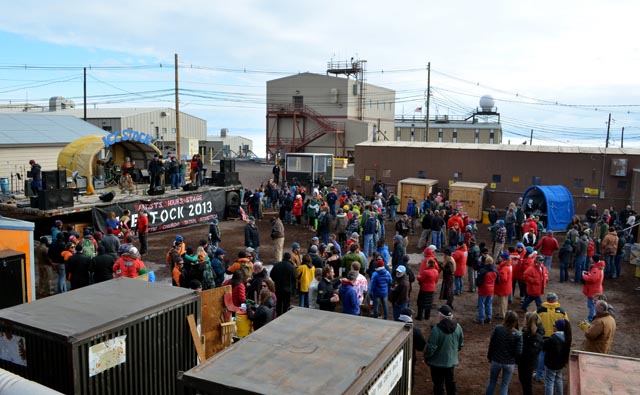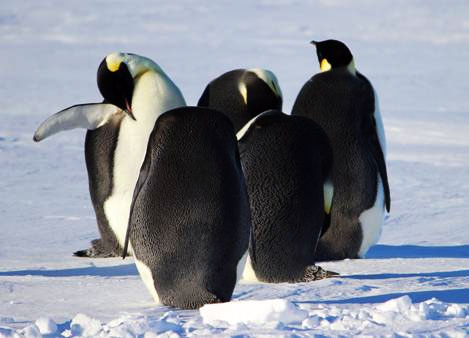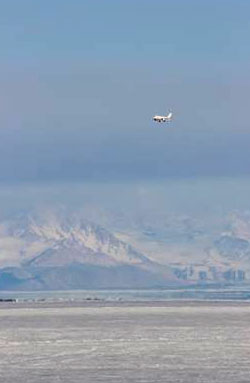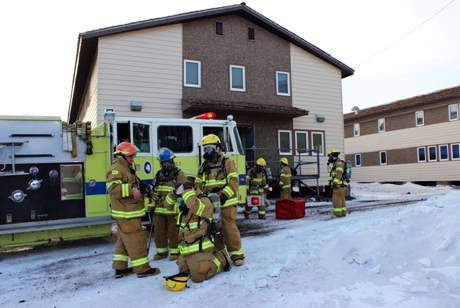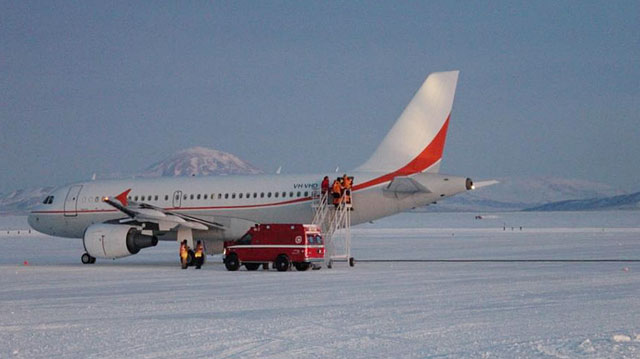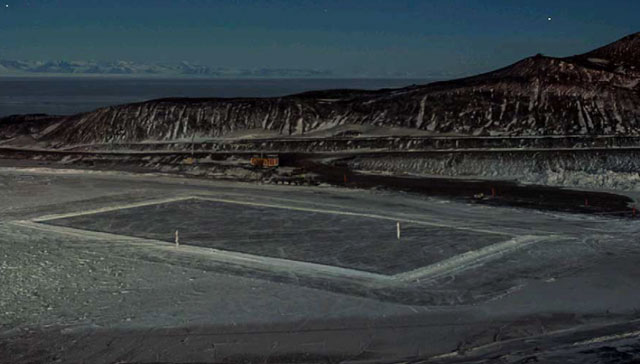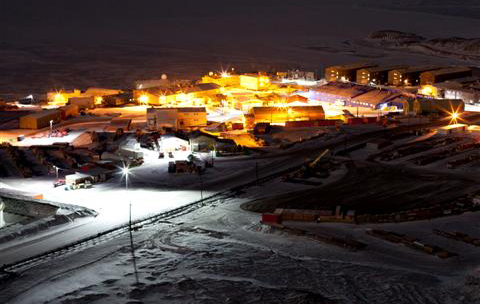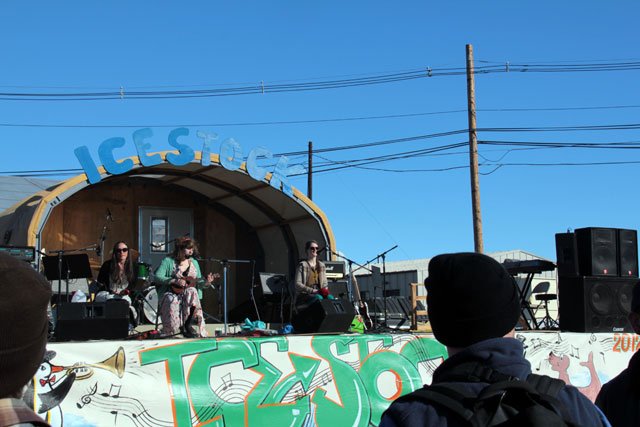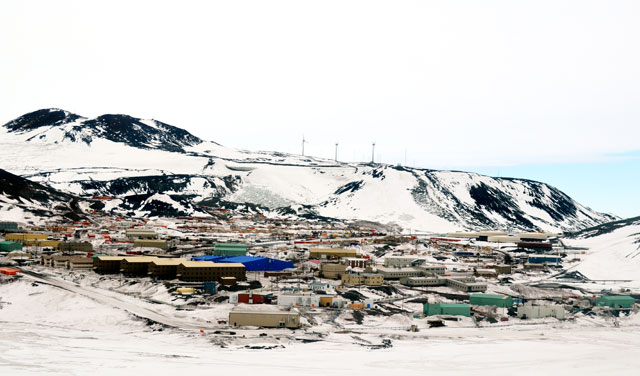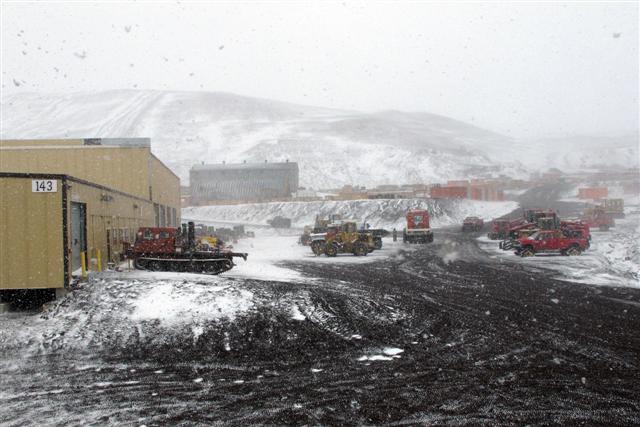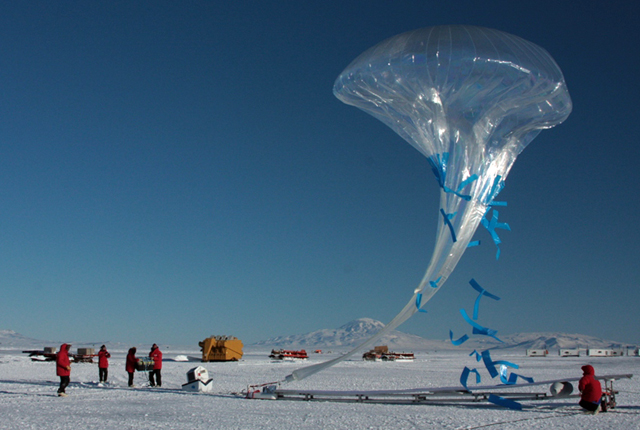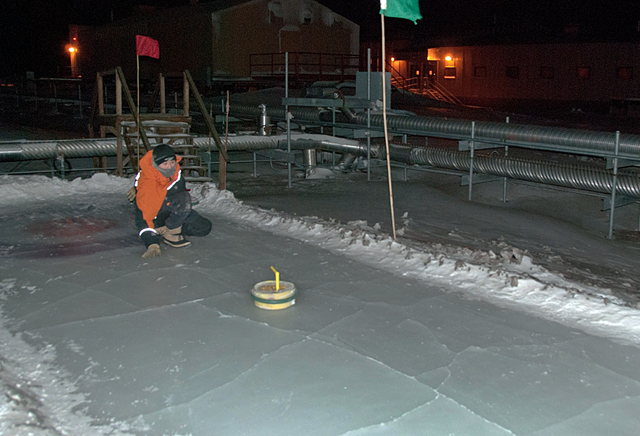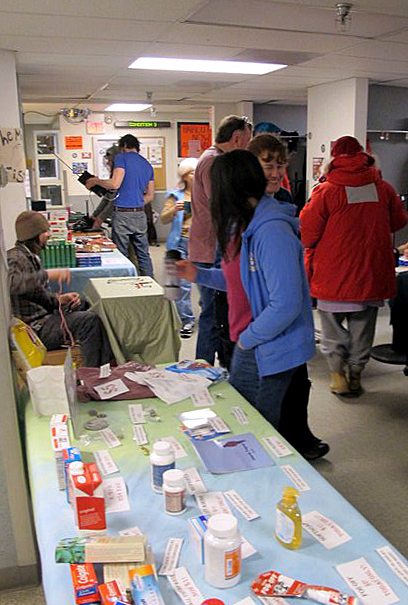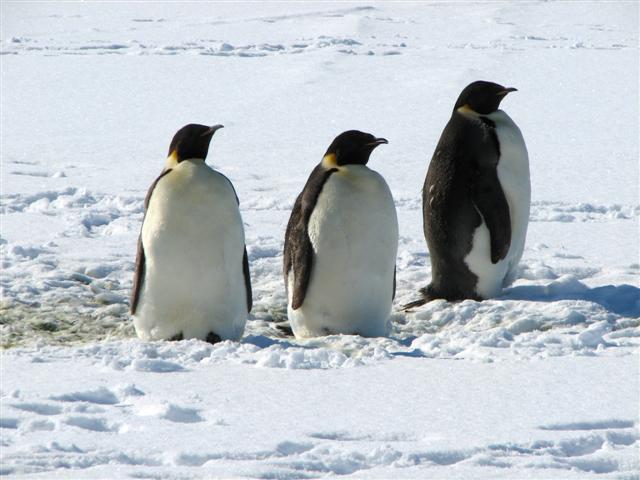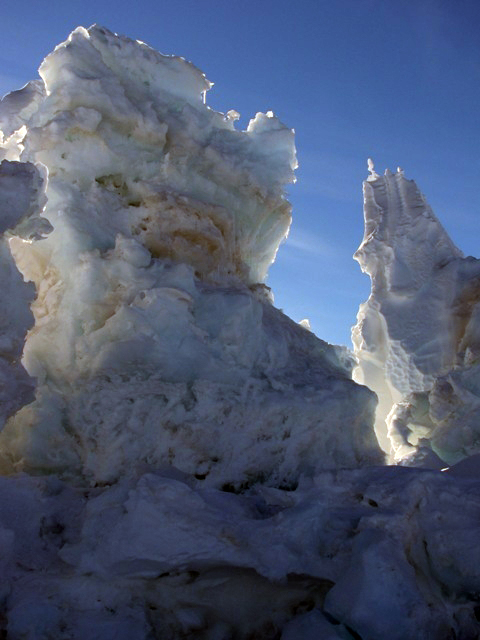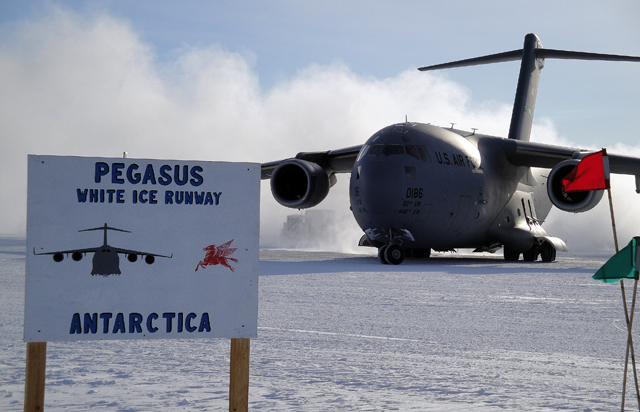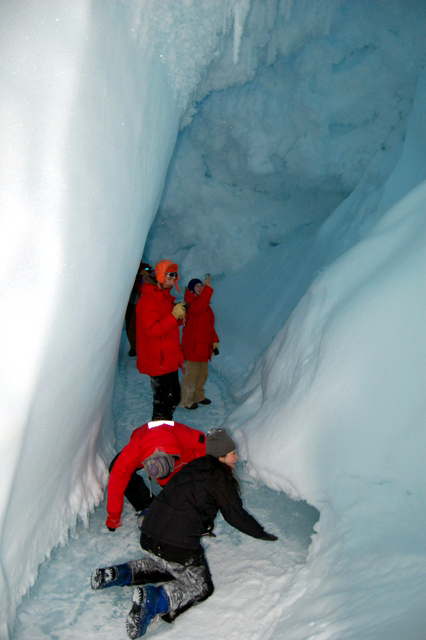|
McMurdo Station Archives
Day in the life: Tracking the movement of four people across winter darknessPosted July 19, 2013
Yes, we celebrated Midwinter’s Day on June 21. We had a feast fit for a five-star restaurant. Our dining room was decorated like a ballroom, and we wore our finest clothes while eating hors d’ oeuvres, dancing and carrying on a tradition that started with the early explorers like Scott and Shackleton. But what does a day look like at McMurdo Station It’s June 11 at 9:57 in the morning, and I’m at McMurdo Station in Antarctica. It’s the middle of the winter, which means I haven’t seen the sun since April 19, but I have felt the cold and wind and seen the Southern Cross at noon. To describe my job today, it’s best to think of Radar O’Reilly from MASH. I am monitoring three radios to my left, seven different frequencies in front of me, and on my right I can communicate with the South Pole Station The reason I’m here today is because a crew of four people left our base in two vehicles to traverse across McMurdo Sound to Black Island, where we broadcast and receive all of our satellite communications, including phone and Internet. The reason you’re reading this now — an email that I sent from Antarctica — is because it was sent from McMurdo to Black Island, then to Australia and finally to Denver. In Denver, my words hopped on the Internet and ended up in The Antarctic Sun. As the crow flies, Black Island is about 25 miles away, but there aren’t any crows in Antarctica or straight roads. By the time the Black Island tractor traverse gets to its destination, the vehicles will have traveled a little more than 60 miles, and it will take about eight hours. This traverse is like astronauts walking untethered from the International Space Station. They are headed to Black Island to do routine maintenance on the satellite receivers and generators. If the generators, receivers and modems are not regularly maintained at Black Island, then we would be both literally and figuratively left in the dark. This is my job today — monitoring the movement of four souls across the winter blackness of Antarctica. Station pulls together for winter-time medical evacuationPosted May 20, 2013
On Tuesday, April 16,the rumors around the dinner table started humming. The people in Fleet Operations knew they had a meeting first thing in the morning to discuss the white ice runway at Pegasus Airfield The ice runway? What was there to discuss? The ice runway is supposed to remain buried until August when we normally get our next flight. The next day it all made sense. One of our community members needed to leave due to a medical emergency, and he needed to leave quickly. 
Photo Courtesy: Joint Task Force-Support Forces Antarctica
A C-17 Globemaster III crew from Joint Base Lewis-McChord, Wash., alongside aeromedical evacuation and critical care air transport team members, safely evacuate a patient from McMurdo Station, on April 22.
The ice runway was covered in up to 10 inches of compacted snow. The electricians would need to hook up power; the fuelies would need to build a fuel pit. Other tasks included setting up lights for the runway, heat for the buildings and many other things to ensure the runway was safe for a plane to land at the start of our winter. For many, their normal 10-hour shift became around-the-clock 12-hour shifts. The galley, once a buzz with rumors of a medevac, was now staying open later to feed those who were working atypical winter hours. The weather was the only entity in McMurdo Station It was projected to take more than a week before the Air Force Taking only six days to turn a snowfield into an Air Force-ready runway speaks for itself. We are a community dependent only on each other right now, and when our mettle was tested, we came together for one of our own. And we had to do it all over again in May when a second medical evacuation occurred. Cold weather can't disguise winter at McMurdo StationPosted April 19, 2013
McMurdo Station Wind gusts blowing more than 60 knots and temperatures dropping to degrees that would be warm if they were on the plus side, we learned quickly what can be in store for us this winter: Cold, cold and cold, with a seven-month extended weather forecast of cold and blowing winds. Even if we hadn’t read Antarctica for Dummies before coming down here, most of us probably had a faint recollection or inkling that winter at McMurdo would include cold temperatures. No one complained about the cold; the biggest problem with March coming in like a lion was that we haven’t had enough time to meet our 143 co-inhabitants of McMurdo. With the cold weather came face masks, goggles, scarves and our standard issue Big Red parkas. Even if my mother was stationed down here, I would not have been able to distinguish her from Jeremy the Plumber, as they would both be clad in the same attire. Most people dealt with this inability to recognize people by simply keeping their head down as they ducked in and out of buildings. I just started calling everyone “Mike.” There are seven “Mikes” in McMurdo this year. With 5 percent of the population named “Mike,” I was only wrong 95 percent of the time. In some aspects of my life, this is a huge improvement. And, when I was met by a cold stare (likely), then I’d run through the other popular names. There are five guys named “Rob” and four named “David” or “Ray.” Throw in a few named “John,” “Dan,” “Brian,” “Jason,” “Richard,” or “Bill,” and now you’re saying, “hello,” to almost 30 percent of our population. The women have proven to be a bit more difficult. Only two share the same name: Cynthia. And one insists on being called “Cindy,” because that’s her name. The Lion of March quit roaring just in time for us to celebrate Easter. With limited supplies, eggs and costuming, we did the best we could. We decorated beverage cans and it was eggcellent. Though it’s a good thing there aren’t any kids down here; our bunny lacked cute and cuddly. Winter under way at McMurdo after a few false startsPosted March 15, 2013
Winter has begun at McMurdo Station The start of the 2013 winter got off to a rough start for the 143 inhabitants of McMurdo Station this year due to mechanical delays of the last flight in Christchurch, New Zealand, and Mother Nature at McMurdo Station. 
Photo Credit: Ben Adkison
McMurdo Station personnel look up to the sky from the Chalet administration building to watch the last plane of the 2012-13 summer season leave.
The 60 remaining summer participants should have flown north on March 5. There were going-away parties, tears and hugs the night of March 4. After the first delay kept those friends and co-workers one more day, there were still hugs, but less tears the night of March 5. By the time the plane finally took off on March 9, travel plans for the summer people had gotten cut short. Not to mention the fact these 60 people were still eating our freshies — real fruits and vegetables that will mostly be gone in just weeks. It seemed like the main form of saying goodbye on Saturday was a kick in the pants and a shove to the back to get them on Ivan the Terra Bus and to the airfield. Now, a few days into our winter season, we’ve had our first All-Hands meeting, first “Welcome to Winter Party,” first watching of the movie, “The Thing,” and we’re currently preparing for our first mass casualty incident (MCI) drill to test our preparedness in case of an emergency. The people to our left, right and across from us in the dining hall are the people on whom we will be depending for fun, work, friendship — and possibly to save our lives. Winter has begun at McMurdo Station. Yes, it really has, and we’re preparing for the worst, but hoping for the best. Summer season winds down with arrival of supply shipsPosted February 15, 2013
The holidays have ended and business around McMurdo Station The first to reach McMurdo Sound was the Russian icebreaker Vladimir Ignatyuk 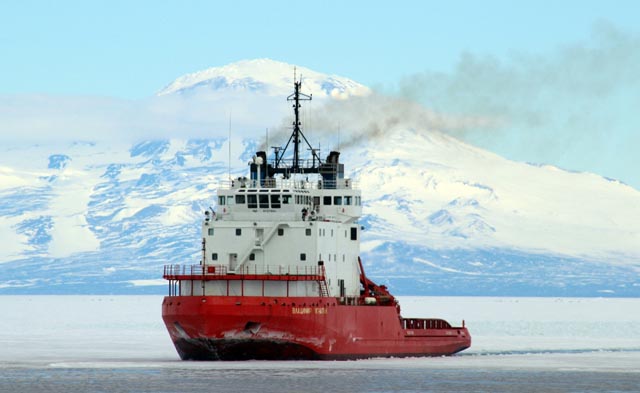
Photo Credit: Deb Wilfong
Russian icebraker VLADIMIR IGNATYUK cuts a channel through the sea ice into McMurdo Sound.
It will be a busy time on the waterfront over the next few weeks. The warmer weather this summer has made for challenges at the airfield, which delayed the return of the Air Force’s C-17 Globemaster III The station continued to receive passengers and supplies via the smaller Hercules LC-130 Sad days passed through McMurdo as news that three Canadian crewmembers of a Kenn Borek 
Photo Courtesy: Pam Hill
The Canadian flag is flown at McMurdo Station in honor of three men killed in a plane crash.
The Canadian flag was flown, flanked by the United States and New Zealand flags, which were in honor of those in support of the recovery effort. A book was made available for members of the McMurdo community to sign to send their condolences and words of comfort to the families. Elsewhere on station, science has picked up speed as members from deep field camps are arriving with their samples. One interesting study of note is a project out of NASA’s Astrobiology Science & Technology for Exploring Planets (ASTEP) Called IceBite, scientists and engineers are developing an ice auger and sampling bit for use on Mars. Ice-rich locations on Mars could have preserved biological material from when it was previously in a liquid state. The terrain in the McMurdo Dry Valleys McMurdo Station gets in a festive mood for DecemberPosted January 12, 2013
December is a festive month all over the world, and McMurdo Station One of the popular holiday events in town is the Christmas Acoustic Show at the Waste Barn. This show began in 2007 and evolved out of the Zimm Brothers Christmas Show that was previously held at the Coffee House. The Waste Barn is the central location for sorting and packaging trash on the station, but on this night, the space is transformed into a small club or concert hall, with holiday decor and artwork. Chairs are lined up for the more than 100 people in the audience. Typically, 10 to 12 performers or groups are invited from the community to play. The feel of the event is that of a private party. The music is great but even an off-key note receives equal applause. It’s a feeling that you are amongst family when you play in this town. The other popular musical event of the season is the New Year’s Eve outdoor concert, IceStock. The event began in the late afternoon with a chili cook-off and soloists performing on stage. The crowd slowly formed, as the evening gradually ramped up to full bands that got the crowd moving. There was even a performance by the local dance troupe with a few added extras. Baby New Year was present to help welcome 2013. Other holiday events included the town Christmas party at the Vehicle Maintenance Facility, complete with Santa and Mrs. Claus on the PistenBully. MAAG, the McMurdo Alternative Art Gallery, always draws local artists and craftsmen to show their works. Every year MAAG also holds an event on stage. This year it was a cabaret show, complete with an illusionist, belly dancer and a burlesque show, amongst other acts. The McMurdo Community Christmas Choir performed at various events including one at MacOps. MacOps is the radio call sign for the Emergency Management and Station Communication at McMurdo. They run the 24-hour communications center for the station and communicate with the various field camps. On this particular day, MacOps helped to spread holiday cheer around the continent through the high frequency air waves. The South Pole Choir also sang a few songs to some of the field camps. Each department typically has its own party to celebrate the season. The chapel had Protestant and Catholic services to remind us of the spiritual origin of the season. And, of course, the kitchen served up a feast for the town to enjoy. McMurdo Station's infamous dishwasher receives proper sendoffPosted December 7, 2012
The kitchen at McMurdo Station Also in the galley are the blue-shirted stewards who deliver the prepared food to the hot food line, scrub the pots, run the dishwasher, mop the floors and maintain cleanliness of the area, amongst a myriad of other duties. The position was changed this year to include food-service responsibilities on some days and janitorial services throughout the station on others. It’s one of the toughest jobs on station, usually filled by those just seeking the excitement of getting to Antarctica. Most have bachelor’s degrees, and more than a few have graduate degrees. They endure thankless hours of smelling like food and dealing with impatient diners. They commiserate with each other, and through the long hours, your coworkers become your family. And when they lose a member of this family, they mourn together. Bertha had difficulty maintaining her pH, and she was inconsistently performing at work. Measures were taken to improve her performance, and experts were called in, but finally it was decided that Bertha the dishwashing machine was to be replaced. She may not have been flesh and bone, but Bertha was indeed part of the family — love her or hate her. And hate her some of the kitchen staff did, for she was not always kind to her attendants. She would unexpectedly spew slime on them or cover them in disgusting film from having to clean her. The stewards saw it to memorialize her before she was removed from the dish room. So, on one bright Antarctic evening in October, mourners came and went, dressed for the occasion: the wake for Bertha the dish machine. One by one, each mourner went into the dish room to say goodbye. Notes where written and attached to her about the staff's favorite memories. Words of kindness were sent in from afar, via Facebook, for the event. Eulogies were read, her favorite songs played, and there was even a group dance performed in her honor. Finally, “Amazing Grace” was sung and the group turned to Gallagher’s, the local pub, for further reflections on her life. It was a fitting goodbye. Elsewhere on station, the more serious activities of scientific research are in full swing, with more than 50 science groups on station by mid-November. Helicopters are seen overhead delivering workers and supplies to camps. Dive huts are active with divers gathering research from the frosty depths of the Ross Sea. The airfields continue to be abuzz with flights. Farther afield from McMurdo Station, the first South Pole Traverse tractor train arrived at the South Pole Station Emperor penguins make guest appearance at McMurdo StationPosted October 26, 2012
Many at McMurdo Station It was certainly a pleasant distraction in the daily routine, as many darted outside, cameras in hand, to the sea ice to get a closer look. I missed the penguins, as they traveled past town, but was able to spot them later near Pegasus, as they sat grooming themselves. Getting a close look was a real treat, and with the help of a zoom lens, a few great shots were taken. Daylight is taking over more and more, and hope for seeing an aurora has dwindled. Sunsets still continue to be breathtaking, and the weather remains cold and variable. Some warming temperatures have arrived, offering a challenge to those working on the Annual Sea Ice Runway. Much effort was put into the runway, which traditionally is the airfield used for the early part of the summer season because it’s close to the station. The job was completed and ready for use for the first U.S. Air Force C-17 Globemaster III The key in building the ice runway is to get the snow removed and the ice exposed. The snow acts as insulation, but once it is removed, the ice will cool further and grow more quickly. Colder temperatures help the ice grow, but warmer temperatures lately have proven a challenge in maintaining it. A number of the C17 landings were made at Pegasus on the permanent ice shelf about 14 miles away. However, it is expected that the ice runway will be fully functional until at least Thanksgiving. The station recreational activities have begun to pick up, with the last events before the beginning of the summer field season including a Hawaiian-themed dinner and a great party with live bands hosted by the Carpenter Shop. Now, with the beginning of the main field season, recreational activities are in full swing, from ping-pong to dodge-ball tournaments. Sun, color and science return to McMurdo in AugustPosted September 21, 2012
August at McMurdo Station 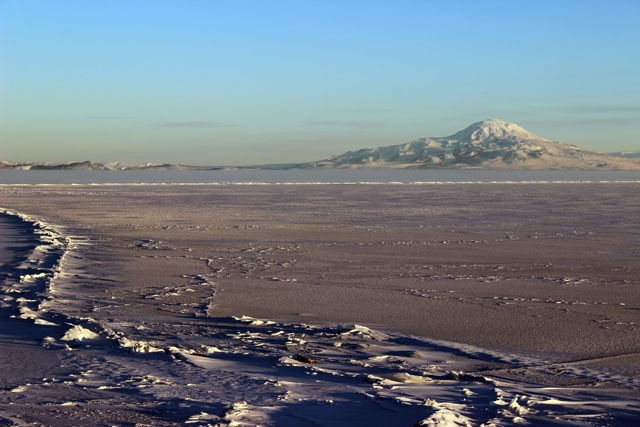
Photo Credit: Beth Jennings
Color returns to McMurdo Sound as summer approaches. Mount Discovery is seen in the distance.
The Crary Science and Engineering Center is showing increased activity, with four groups working on projects. One team, led by Xinzhao Chu A pair of researchers from Oregon State University Brad Buckley’s 
Photo Credit: Beth Jennings
Theresa Gilliland and Ray Sundby unicycle in the gym at McMurdo Station.
With the new season come some changes at the station. Plans are in the works for renovations to some of the dormitories. Work will begin this summer to refurbish and remodel — the “smell of fresh paint” — Building 155. The goal is to no longer have five to six people per room in that building and to keep occupancy to three per room maximum. There are plans to remodel one of the dorms for singles, and to eventually update many of the other dorms over the next several years. The social scene this time of year is slightly more active than winter, but much slower than the summer. Gallagher’s Bar is still popular on Saturday nights, particularly since Southern Exposure has not opened yet. American Night at Scott Base McMurdo pulls off medevac shortly before Winfly beginsPosted August 24, 2012
McMurdo Station The Fleet Operations team ensured the airfield at Pegasus White Ice Runway The medical evacuation, which also brought in some mail and highly coveted freshies, came with only about 11 days before the beginning of Winfly (winter fly-in). Station operations are going full steam in anticipation of the arrival of more than 300 scientists and support staff this month. Multiple departments continue to be involved in opening buildings that have been closed all winter and de-winterizing vehicles that have not been driven since February or March. Construction of the ice pier in Winter Quarters Bay has been progressing on schedule, with a layer of cable reinforcement installed in late July and pours being made every two to four days. If all continues to go well, the pier may be able to support vessel operations in February. McMurdo held its own version of the Olympics to coincide with the games being held in London. Several teams formed their own “countries,” complete with flags and costumes, and competed in events such as the cotton ball pass, twister, hula hoop, and a race wearing extreme cold weather gear. While the team from Scott Base 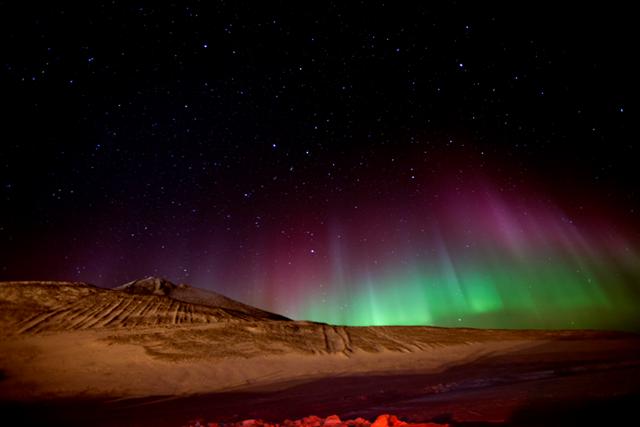
Photo Credit: Devin Stross/Antarctic Photo Library
An aurora near McMurdo Station during the 2012 winter.
The first weekend in August featured a special Ballpark dinner presented by the kitchen staff, complete with concession stand service (featuring hot dogs, hamburgers, pizza, pretzels, and ice cream), Wii baseball, and a small-scale baseball diamond in the dining room. The dinner was followed by the last open mic night of the winter season, which featured a full roster of musical talent from both McMurdo and Scott Base. Filming for the 48-hour film festival also took place the first weekend in August, with stations across Antarctica being invited to submit a short film featuring five specific elements chosen by last season’s winning stations. [See previous article — At the movies: McMurdo film fest draws record number of entries from 21 research stations around the Antarctic.] This year’s films had to include a queen as a character, a map of the station and a computer mouse, the sound of ice cracking, and the line of dialogue, “I’ll save you.” We’re all anxious to view the 27 films submitted by 20 stations representing 11 countries and vote for our favorites! Midwinter festivities highlight a busy June at McMurdoPosted July 20, 2012
Midwinter, that uniquely Antarctic holiday, was celebrated at McMurdo Station Although there are only 14 people occupying New Zealand’s Scott Base this winter, they graciously welcomed more than 70 plungers from McMurdo, who were crazy enough to think jumping into 28-degree Fahrenheit water in the middle of winter was a good idea. Thankfully, Mother Nature cooperated and turned off the wind machine, so the event was by all accounts a huge success. The Kiwis and all the McMurdo personnel who helped coordinate and support the event deserve a huge thank you for spending most of their day off helping everyone else have a fun and safe time. The annual Midwinter Dinner was a fun-filled evening. Numerous community members pitched in to design and create invitations, make decorations to fit the “Winter Skies” theme, help the kitchen with food preparation during the week leading up to the dinner, and coordinate setup and cleanup. [See previous article — Waiting for the sun: Antarctic research stations observe winter solstice.] The kitchen crew once again proved that they’re an insanely talented group, creating a sumptuous feast, featuring staff specialties such as crispy duck skin, salmon Wellington, and spring rolls with goodies from the greenhouse. The gourmet dessert spread included an assortment of homemade marshmallows and cakes, complete with a chocolate fondue fountain and real ice cream. After dinner, everyone enjoyed hamming it up for pictures in the photo booth and showing off their moves on the dance floor. The Midwinter Race and Relay was delayed by two weeks due to unfavorable weather on the original date. When race day finally came, 31 brave racers, including three relay teams, showed up to tackle the mile-long course through town. Despite cold temperatures and a stiffer-than-desired breeze, the racers proved their toughness in completing the course and enjoyed some snacks and hot beverages in the Coffeehouse as a reward for their efforts. It’s not all fun and games at McMurdo. By the end of June, enough ice had finally built up in Winter Quarters Bay to begin constructing the ice pier. Fleet Operations jumped into action, clearing the surface and building berms in preparation for the first pour on July 3. Two more pours have since been completed, so only time will tell whether we end up with a giant ice cube or a usable pier this year. [See previous stories — Without pier: Floating dock from McMurdo Station found locked in sea ice and Strong finish: Successful cargo operation completes challenging logistics season.] All the activity on the ice is just another reminder that winter is drawing to a close, with the first flight of Winfly (winter fly-in) due to arrive on Aug. 20, bringing much anticipated fresh fruit and vegetables, mail, and “orange people” among our pale-faced midst. These remaining weeks will bring the conclusion of the pool league, more gatherings to watch TV shows and movies, the 24-hour Film Festival, an Antarctic Service Medal ceremony, the opening of buildings around station, and the return of the sun. Hope we can all find our sunglasses! Winter weather at McMurdo perfect excuse to play indoorsPosted June 22, 2012
Mother Nature has not been terribly cooperative for those wanting to participate in outdoor activities so far this winter at McMurdo Station Windy and cloudy conditions prevented the few brave souls who took a ride to Castle Rock on a stargazing trip from seeing much. A few hearty folks battled the elements on Memorial Day for a flag-raising ceremony, but the runners who signed up for the Mid-Winter run and relay didn’t fare as well; they will have to wait a couple of weeks as the race was postponed due to forecasted storms. 
Photo Credit: Gracie Cole and Kricket Scheerer (inset)
Volunteers help clean the McMuro wastewater facility.
The darkness and cold has provided the perfect excuse to spend free time indoors, and a good crowd turned out when the library was transformed for a wine-tasting event. A variety of red and white wines that were not yet available in the store was offered for tasting, along with gourmet snacks provided by the kitchen. Tasters were also able to admire some of the eclectic art pieces that have been collected over the years in the library while enjoying acoustic music performed by many of the talented musicians on station. A successful Monday night lecture series has included separate travelogues on trips in Africa (by plane and overland truck), as well as a humorous tale of one worker’s journey from dorm to work center (including factoids of dubious historical accuracy). Additional presentations about work being done at McMurdo and New Zealand’s Scott Base Brendan Roberts, our lone winter-over science grantee, gave a presentation on the year-round research conducted by his group. The multi-year project uses LiDAR (Light Detection and Ranging) technology to measure middle and upper atmosphere temperatures, which can be indicators of climate change. Since the LiDAR is operated from Arrival Heights 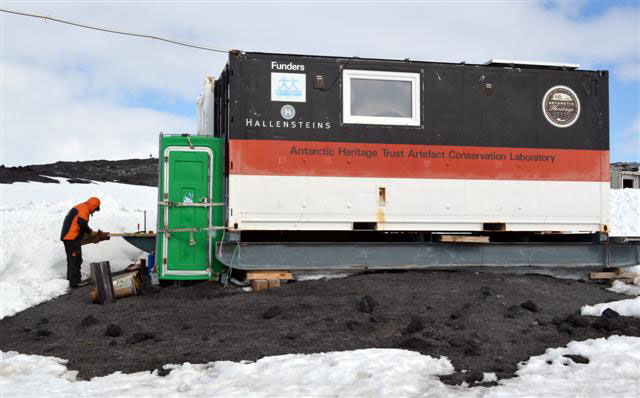
Photo Credit: Peter Rejcek/Antarctic Photo Library
The New Zealand Antarctic Heritage Trust lab at the Cape Evans site over the 2011-12 summer.
Two conservators from the New Zealand Antarctic Heritage Trust (NZAHT) The small population during winter offers the perfect opportunity to do some deep cleaning at the Wastewater Treatment Plant. Volunteers participated in a “poo dive” to help muck out two treatment trains not being used this winter. It was a group effort, as various departments, including EH&S, the Fire Department, Medical and Waste, were involved to make sure the operation went off without a hitch. The volunteers were fully suited up and spent time shoveling the accumulated gunk into buckets, which were hoisted to walkways overhead and then dumped into waste triwalls to be shipped out next year. By all accounts, they had a great time getting dirty in the name of community service. McMurdo enters winter maintenance modePosted May 25, 2012
The winter season at McMurdo Station Operations have continued as normal after the U.S. Antarctic Program Departments are keeping the station running and preparing for the upcoming summer science season by doing maintenance on equipment, receiving new materials that arrived via supply vessel and cargo flights at the end of summer, and getting organized for next season. On April 24, the sun dropped below the horizon for the last time until August 19. Recreation trips to Castle Rock, Arrival Heights and the Pegasus crash site were organized to view the event. We enjoyed some beautiful sunsets in the weeks that followed, providing the last glimpses of light to be seen until the glow starts forming on the horizon again as the end of winter approaches. The amazing kitchen staff also provided a sumptuous Italian feast to celebrate the final sunset, complete with fresh salad, an impressive variety of pasta dishes, and gourmet desserts. Those who were here last year may be experiencing déjà vu as the old ice pier is once again threatening to drift away after several cables attaching it to shore broke loose. It looked like we had a good start for the new ice pier to be built this winter until the ice in Winter Quarters Bay was blown out by a storm in early May, so we’re back to square one. Despite the occasionally gusty conditions, a new record high temperature for May of 30 degrees Fahrenheit was set, making it feel more like summer than winter for a brief time. When we’re not busy working, various departments have helped spice up the social scene. The Berg Field Center, Mechanical Equipment Center, and Aircraft Ground Equipment departments all hosted parties, with live music showcasing some of McMurdo’s local talent, and the Vehicle Maintenance Facility held a horseshoes tournaments. Our intrepid recreation coordinator, with the help of the community, has made sure plenty of options for fun are available, including movie/TV nights, card games, dancing lessons, bingo, trivia, karaoke, burrito bar and more. The firefighters have also been showing off their shiny new engines, offering rides in the trucks and tours of the Firehouse on Sundays. Station manager Harry House led several trips to build igloos along the Castle Rock Loop trail, resulting in two complete igloos and a partially finished third one. Camping trips to the igloos should start soon. Matt Nelson has also been leading frequent tours to the Discovery Hut, sharing some Antarctic history with the community and documenting a variety of names inscribed on the walls by early explorers. Science ramps down as ship operations power up at McMurdoPosted February 17, 2012
The new year at McMurdo Station More than 40 science groups were being supported from McMurdo to begin the year, with more than 70 people using the Crary Lab and nearly 100 working at field camps. The second of two Long Duration Balloons Of course, what would a field season be without penguin research? Scientist David Ainley 
Photo Credit: Holly Gingles/Antarctic Photo Library
The research vessel NATHANIEL B. PALMER in McMurdo Sound at the end of science cruise in February 2012.
Not far behind Adélies in the charismatic megafauna category are Weddell seals. A research team led by Dan Costa Seals are outfitted with autonomous sensors that collect oceanographic data as they swim. The data are transmitted back to the Long Marine Lab Weather is always a topic in Antarctica, and the month started off where most of the end of 2011 had left off — unseasonably warm. So warm, in fact, that U.S. Air Force C-17 flights from Christchurch started arriving and leaving in the early morning hours, when temperatures are at their coldest. The relatively warm temperatures also made it difficult to maintain the snow roads from Ross Island to the airfield. However, the brief Antarctic summer started to cool off as the month wore on. That was particularly good news for the rapidly deflating ice pier, which had never properly solidified during the winter and early summer. [See previous article — Without pier: Floating dock from McMurdo Station found locked in sea ice.] While it would eventually be pulled out of the way for the cargo offload in February, it was stable enough to support foot traffic for the fuel offload at the end of January. The Russian icebreaker Vladimir Ignatyuk arrived in McMurdo Sound and quickly cut a channel for the fuel tanker Maersk Peary, which arrived at the wharf on Jan. 27. Due to the instability of the ice pier, the ship was moored to bollards on both sides of Winter Quarters Bay. The ship delivered more than seven million gallons of fuel, unloading the last drop in less than three days. Science rapidly ramped down throughout the month, as station personnel gathered their strength for the mid-February arrival of the cargo vessel, an intense, 24-hour-a-day operation made even more challenging because of the unavailability of the ice pier. Instead, the U.S. Army has come to the rescue with a modular pontoon causeway that will be built in place of the ice pier. The last flight of the season for McMurdo is scheduled for March 2. Holidays in McMurdo offer reprieve from stateside hustle and bustlePosted January 13, 2012
Many people who come to work at McMurdo Station 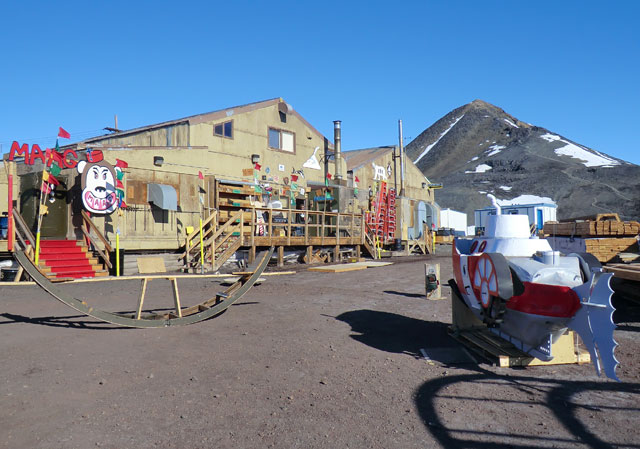
Photo Credit: Stephanie Prince
The McMurdo Alternative Art Gallery takes place every year at Christmas.
Instead of hustling through a maze of sweaty shoppers in an overcrowded mall, McMurdo residents perused homemade crafts at the season’s biggest craft fair in the town galley. No one had to stay up late wrapping last-minute presents on Christmas Eve; instead, people interacted with alternative art forms created by Antarctica’s finest craftsmen and artists at MAAG — the McMurdo Alternative Art Gallery. Each year, elves from McMurdo Station’s carpentry shop transform their workspace for the one-night art extravaganza. Artists gave the gift of creative expression this holiday season with exhibits ranging from an outdoor adult-sized seesaw to an enclosed bunk-sized sanctuary called “The Secret Cozy Place.” Alternative art projects abounded, as well as paintings, drawings, comics, metalworkings and a “get your own mug shot” photo booth. An eccentric fashion show and all-night dancing capped off the event. December wasn’t all fun and games, though. A lot of departments — from Fuels to Fleet Operations to Shuttles — put in hard work to make the transfer from the sea ice runway to Pegasus Airfield at the beginning of December. This year, a partially new route to Pegasus is being used, and although road conditions were rough at the beginning of the month, warm and sunny weather for much of December has led to a nicer, smoother ride for all those going back and forth to the runway. A nearly perfect weather pocket on Dec. 25 allowed the launch of the Cosmic Ray Electron Synchrotron Telescope (CREST) The CREST instrument is an electron and synchrotron detector suspended below the balloon. It will circle around the continent once or twice before falling back to Antarctica. This detector is an experimental design that will look for evidence of supernova events. People of McMurdo rang in the New Year in style listening to live music at IceStock, Antarctica’s biggest music festival. A chili cook-off got the event started out right, fueling concertgoers for six hours of music and dancing. Spicy chili, sunshine and a break from the wind allowed all to let loose and celebrate all the new things to come in 2012. McMurdo moves into next phase of summer season as sea ice ops wrap upPosted December 9, 2011
McMurdo Station Every week the U.S Air Force C-17 brings in new groups of scientists. By the end of the month, there were about 170 researchers in town and another 70 in various field camps far and wide. About a dozen field camps are supported by helicopter, and nearly an equal number by fixed-wing aircraft. Terry Wilson The WAIS Divide Closer to McMurdo Station, science groups worked on the sea ice to collect specimens for ocean acidification studies on fish and sea urchins. Other teams are conducting studies on Weddell seals, from a long-term population study that dates back to the 1960s to a first-year project to study how the pinnipeds regulate heat in an icy environment. 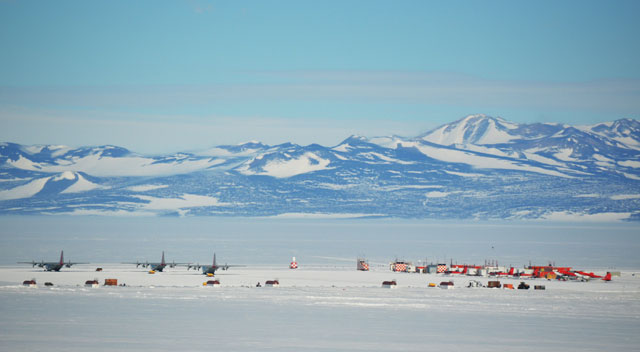
Photo Credit: Peter Rejcek
The sea ice runway the week before the airfield was relocated to Pegasus.
As always, weather was a big wild card, with bluebird skies and warm temperatures early in November, which caused McMurdo’s blanket of snow to fray, revealing the brown volcanic dirt and rock underneath. However, a mid-month series of storms moved across the region, freshening the snow but causing numerous disruptions in the helicopter and plane schedules. That meant delays getting scientists to field camps. It also meant almost no fresh vegetables for the annual Thanksgiving feast. But the galley performed its usual holiday magic, serving up turkey and ham, with all of the trimmings, including dozens of pumpkin and pecan pies. The milder than normal temperatures kept the sea ice runway and the snow road from Ross Island to the airfield in relatively good condition. Preparations were made for the upcoming move from the sea ice runway to Pegasus airfield, which requires hauling the entire facility onto the permanent ice shelf. No amount of mild weather will help the new ice pier this year, which never got thick and solid enough over its construction during the winter because of above-average temperatures. The pier is needed to transfer fuel and cargo from vessels that will arrive at McMurdo in January. Contingency plans are currently being developed, with the most likely scenario involving installation of a modular causeway, a temporary floating pier, by the U.S. Army. McMurdo activity ramps up with beginning of summer field seasonPosted November 11, 2011
The 2011-12 summer field season at McMurdo Station That was partly due to weather, which played its usual havoc with flight schedules between Christchurch and McMurdo, as well as later flights between McMurdo and the South Pole Station 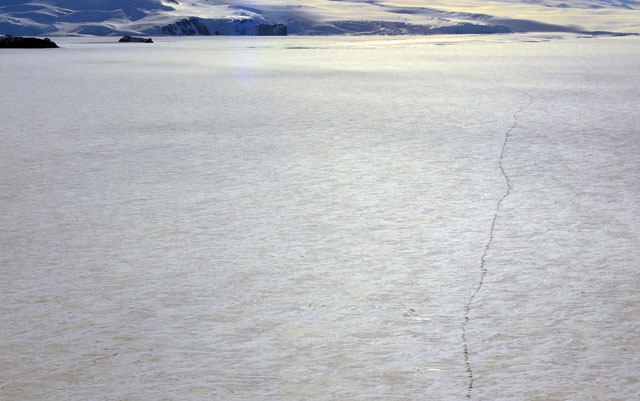
Photo Credit: Peter Rejcek
Cracks in the sea ice, such as the one at the right, have caused some logistical challenges for science operations.
However, toward the end of the month, the population had hit more than 900 people, some of them awaiting transport to South Pole, which received its first flight of the summer on Oct. 24, a week later than planned because of poor weather on the continent. October in McMurdo has also proven to be a tough place for driving, as well as flying. Large cracks in the nearby sea ice have limited researchers from accessing traditional study sites. For example, principal investigator Robert Garrott’s Sea ice conditions are significantly different this season after all the ice blew out of McMurdo Sound, the first time in about a decade. Slightly warmer temperatures over the winter also played a role, resulting in more active cracks than in seasons past. However, toward the end of the month, sea ice conditions improved somewhat, as cooler temperatures prevailed, with several cracks freezing solid enough to allow tracked vehicles to access some areas. The cooler weather also helped ongoing efforts to build a new ice pier, which has been slowed by warmer-than-normal temperatures over the winter and spring. That’s all good news for the 17 research groups, representing more than 60 scientists, which were on station near the end of the month. The first of the scientists with the McMurdo Dry Valleys Long Term Ecological Research (LTER) Meanwhile, penguin research Paul Ponganis McMurdo Station personnel begin early-season activitiesPosted October 21, 2011
September was a very busy month at McMurdo Station Heavy equipment operators from our Fleet Operations department were occupied with constructing a new runway on the sea ice, as well as completing road maintenance on the McMurdo Ice Shelf to the launch site of the Long Duration Balloon 
Photo Credit: DigitalGlobe/Antarctic Photo Library
A satellite image of Ross Island, the sea ice runway (straight down from the tip of the island) and the Long Duration Balloon facility at Williams Field (to the right of the island).
The sea ice proved to be a real challenge for the grantees and equipment operators throughout September. Due to a combination of factors — late winter formation, warmer temperatures, heavy snowfall, and windy storm systems — the ice has formed many cracks. Specific research areas to our north, such as the sea ice edge near Cape Royds and the region around Cape Evans, have been blocked off by large cracks prohibiting safe passage. These conditions have been particularly challenging for the two-person science team of Jeff Bowman and Shelly Carpenter, who are collecting delicate frost flowers, which form at the edge of the sea ice. [See related article: Full bloom.] However, the team from the University of Washington Meanwhile, carpenters worked steadily on projects such as building fish huts, a berthing sled for the South Pole Operations Traverse crew, and crates for the deep-field camps and traverses. People were busy completing their field safety and vehicle operation training. Also, our helicopter mechanics from PHI (Petroleum Helicopter, Inc.) Slowly and steadily, McMurdo gets ready for the summer. McMurdo crews busy creating roads and building ice pierPosted September 23, 2011
The Winter Fly-in period, called WinFly for short, officially began in August. Over the span of two weeks, seven scheduled U.S. Air Force Globemaster III C-17 flights brought an influx of people and cargo to McMurdo Station Weather windows would come and go, and this made it a little tricky for the Air Force to land their planes safely. It definitely kept cargo crews, heavy equipment drivers, airfield ground equipment personnel and firefighters busy, as they continually maintained Pegasus airfield Incoming scientists and support personnel spent extra days in Christchurch, New Zealand, while they patiently waited for news of good weather. On the flip side, everyone here on station patiently waited for colleagues and friends to arrive to begin helping with the massive task list of final preparations for the summer science season. 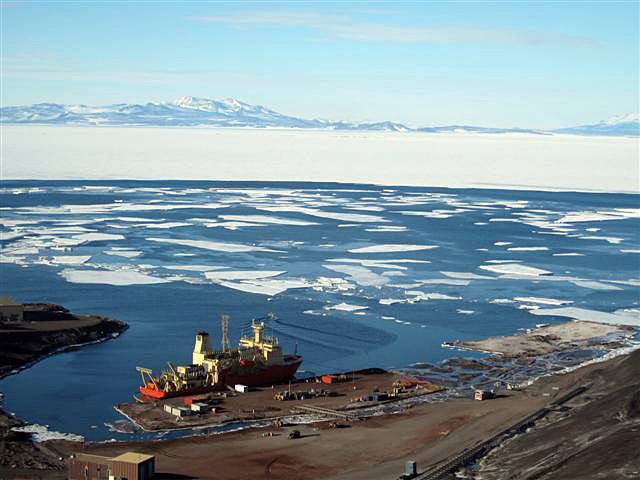
Photo Credit: Jeff Scanniello/Antarctic Photo Library
The research vessel Nathaniel B. Palmer docked at the McMurdo Station ice pier earlier this year before the pier broke apart, requiring construction of a new one over the winter.
The two science groups that arrived here during WinFly got to work right away. Divers from Adam Marsh’s The freshly reinforced Fleet Operations department has been busy creating a road out to the site of a new Ice Runway to be built before the summer Mainbody season in early October. There is a giant crack in the sea ice that forms each year in front of McMurdo. Historically, it has been a manageable crack for vehicles to cross, but this year it is so large that an end-run road around the crack is required to get to a newly surveyed site for the runway. Work also continued on a new ice pier to replace the one that broke apart at the end of last summer season, partly thanks to some powerful storms that helped clear out the sea ice in McMurdo Sound. Relatively warm temperatures over the winter have slowed progress, as crews work to thicken the ice before the arrival of the icebreaker, cargo and fuel vessels in January. There’s definitely no lack of work to do as the summer field season rapidly approaches. The first flight of Mainbody is scheduled for Oct. 3. Late winter storms bury McMurdo before the arrival of first flightsPosted August 12, 2011
The month of July came in with a bang and went out with a blow here at McMurdo Station Even surrounded by darkness and cold, McMurdo residents managed to conjure the true feel of an Independence Day festival within the confines of the VMF (Vehicle Maintenance Facility). The inside of the maintenance shop — usually filled with trucks, dozers and cranes in various stages of repair — was converted into a full-fledged carnival, including games of chance, photo booths and a dunking tank. Traditional carnie foods were offered, such as corn dogs and fried dough. Four different types of chili vied for the title of Best Chili in the cook-off. In a show of community spirit, donations were taken throughout the evening to help two dear friends who had to cut their season short due to the medevac in late June. All red, white and blue aside, it was this outpouring of generosity for our fellow winter-overs that really made the evening memorable. Not to be outdone, the Waste department hosted a party of its own to usher out the month, transforming the Waste Barn (which is normally used for housing and sorting trash tri-walls) into Bob’s Country Bunker and Roadhouse, complete with a western bar and swinging saloon doors for a real country hoedown. Taking center stage was the multitude of talented bands that have made up the strong musical core of the winter: Uncle Skeeter’s Freeform Amalgam, Johnny’s Rebels, Tears for Piers (an all-girl rock band) and The Kountry Rainbows, each bringing new, country-themed songs to the stage for everyone’s enjoyment. And what hoedown would be complete without a good old-fashioned barbeque? Burgers and corn on the cob from the grill, served throughout the evening, really made the transformation complete. The real headliners for the month of July, however, were the series of storms that pounded the station with high snowfall and gale-force winds. At McMurdo Station, weather is classified into three categories, depending on its severity: Condition 3, Condition 2 and Condition 1, with the last being the most severe weather due to cold temperatures, high winds, and/or low visibility. During a Condition 1 event, normal station operations are suspended, and movement outside is limited to essential travel, with escorts from the search and rescue (SAR) team. 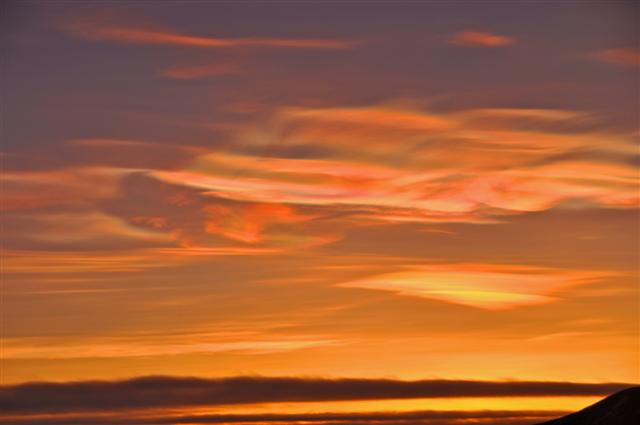
Photo Credit: Kelly Speelman/Antarctic Photo Library
Nacreous clouds above McMurdo Station. The clouds are involved in the chemical processes in the atmosphere that cause ozone loss above Antarctica, which begins in the austral spring.
Over the past several weeks, the station has been hit with several bouts of Condition 1 weather. According to weather forecaster Christine Blais, these storms and the overall pattern of unsettled weather are normal for this time of year, as the weather patterns shift in the upper atmosphere due to the springtime movement of the Earth’s axis that brings back the faint glow of sunshine on our horizon. Just as the United States has been stuck under a pattern of severe hot weather for several weeks, McMurdo experienced its most bitterly cold temperatures the weeks prior to the latest round of storms. As this system broke, warmer temperatures of up to 23 degrees Fahrenheit moved in. These warm temperatures, coupled with the volatile upper atmosphere unrest, brought heavy snow and high winds. Weather observer Angela Garner reported that the estimated total snowfall over the course of the two storms was almost five feet. Coupled with sustained winds of 70 miles per hour, with gusts reaching 83 mph, we had some really nasty weather outside! While we all reveled in the exciting storms and the change from daily routines, no one was excited about the sheer tonnage of snow that had to be moved once the weather had settled down. Besides causing visibility issues, those high winds also caused mountainous drifts to form all over the station by carrying snow from the nearby ice shelf. McMurdo residents banded together with shovels to help one another clear doorways and pathways. Kudos should be given to Bob Teuscher and his Fleet Operations team, as they once again spent countless hours manning the heavy equipment it takes to move those mountains of snow away from the station. With yet another storm raging outside as this article is being written, McMurdo braces itself for another few days of shoveling and snow clearing. We look toward the horizon for a break in the seemingly endless line of storms for a glimpse of the evasive sun that has been hidden for so many months. While we have all seen the ever-lightening glow of the sky around us, the true sunrise, with the sun making a brief appearance above the horizon, will take place in just a few short weeks on Aug. 19. This will be both the symbolic end to a long winter and the official one, as the first flight of WinFly will occur the following day, bringing in a plane full of new people — presumably to help with the shoveling. McMurdo Station supports successful winter medical evacuationPosted July 15, 2011
It was the winter solstice of 1911 in Antarctica when the crews of Capt. Robert F. Scott, Roald Amundsen, and other explorers around the continent pulled out all of their best food and clothes to celebrate the impending return of the sun. They dined, played music, danced, and enjoyed a holiday that most people in the world overlooked. June 21 was especially significant to these men because it marked the turn of the winter and the slow return of light to this frigid landscape. The following Antarctic summer, Scott and Amundsen set out on their famous and fateful race to the South Pole. 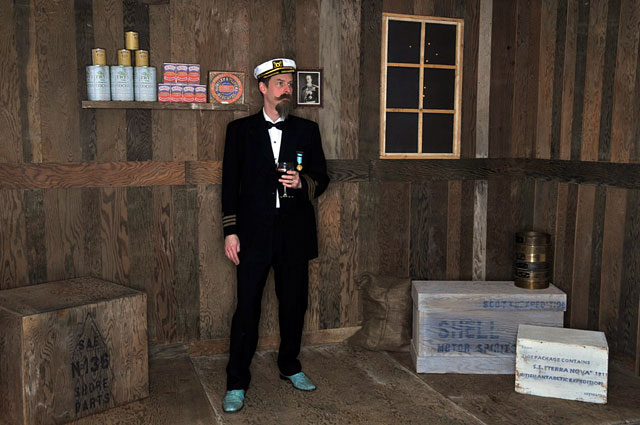
Photo Courtesy: Daniel Jennings
Daniel Jennings poses in his Capt. Scott outfit in a replica of the explorer's hut that Jennings built for the Midwinter festivities.
Here, in 2011, the centennial significance of that event was especially felt as the residents of McMurdo Station Nearly every single person on station lent a hand for the festival, and the warm camaraderie abounded as friends joined to eat and dance together. The station cooks spoiled us with an amazing menu including lobster bisque, tea-smoked duck, coconut-infused halibut, duchesse potatoes with truffle caviar, cheesecake, and a whole lot more tasty goodness to stuff our stomachs. As the official event winded down, many of the station personnel retired to our friendly neighborhood pub Gallagher’s to continue the celebration and enjoy the silly entertainment of McMurdo’s only hip-hop dance troupe, the Kool Kids. I wonder how Capt. Scott would have reacted to seeing such dancing on this frozen island a full century after his own night of mirth and revelry. There are no doubts that the good Captain would have approved. 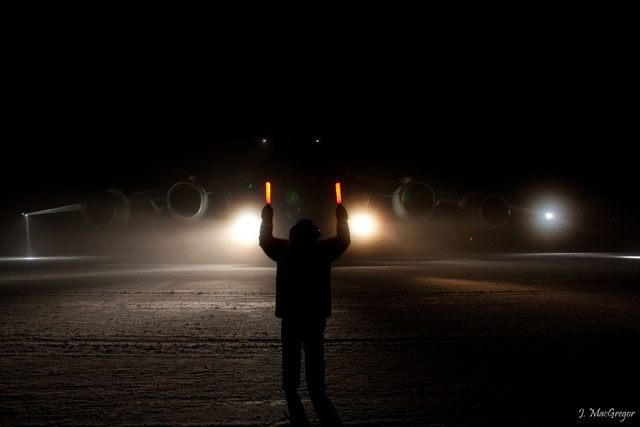
Photo Credit: Jereld MacGregor
A member of the Pegasus airfield ground crew directs an Air Force C-17 airplane during the winter medical evacuation.
June was a busy month for most all departments here, yet life stayed pretty quiet and steady in the few weeks before the winter solstice. During the last week of the month, however, nearly every single department on station put its tasking on hold to help accomplish a very significant mission. A friend of ours had become very ill and needed a medical evacuation to Christchurch, New Zealand, for additional care. With deliberate resolve and teamwork, we brought the runway at the Pegasus airfield online to receive a medical crew aboard a U.S. Air Force C-17 airplane. The aircraft flew down to the dark Antarctic and landed safely with the aid of night-vision goggles to pick up our friend. See Air Force news story The midwinter medevac mission was a huge success, and the reward for everyone’s hard work was not insignificant, as a pallet with some 6,000 pounds of fresh fruit, vegetables and mail was also offloaded for the residents of McMurdo and New Zealand’s Scott Base McMurdo Station winter personnel pursue plenty of recreational opportunitiesPosted June 24, 2011
While May flowers are popping up in the northern hemisphere, the month of May blew by McMurdo Station Always a busy place, McMurdo Station has been hopping this year with the addition of our new recreation coordinator, Gracie Sorbello. A master at juggling a schedule and the many unique interests of our diverse population, Gracie, along with many other stellar volunteers, has managed to pack each week with recreational events, ranging from the intellectually sublime to the raucously competitive. During the winter, our daily tasking is very routine. Unlike the summer season, which is full of scientists and the busy movements of people across the continent, winter moves at a slower and steadier pace. 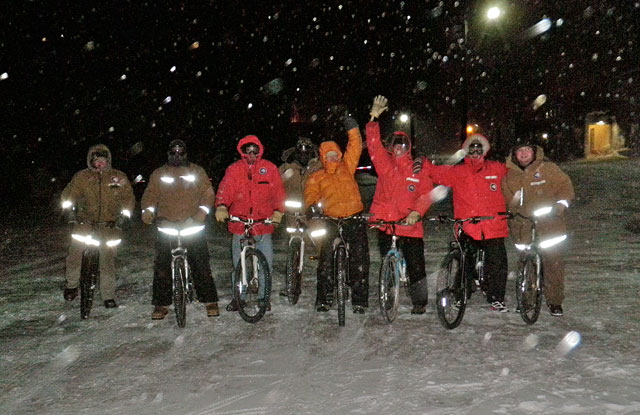
Photo Credit: Jeff Kennett
McMurdo personnel pause during Bike to Work Day (held in conjunction with the one in Denver) for a group shot. Temperatures with windchill were minus 47 degrees Fahrenheit.
The role of the winter staff is to repair and recover the station from the wear and tear of the massive summer population, while making all the preparations needed to welcome back the hustle and bustle of science for the next field season. The necessary tasks of painting walls, fixing floors, organizing scientific equipment, and counting and receiving endless milvans of new stock and inventory give way to recreational pursuits in the off-hours. Those with a competitive streak have many ways to put it to good use through regular game nights and tournaments. The crew at the Vehicle Maintenance Facility hosted a horseshoes tournament in the shop, pitting both expert throwers and inexperienced newbies against one another in double-elimination play. A cribbage tournament brought out the card shark in many, with a large number of the population signing up to play. There have also been darts tournaments, as well as a weekly game night for those more interested in games of strategy over games of skill. For those looking for more intellectual pursuits, there are no lack of opportunities to expand and edify their minds. One option includes “TED talks,” a series of short videos featuring the great minds of society discussing topics that they are passionate about. Four short “lectures” are presented each week in the galley to a sizeable crowd, with the opportunity for discussion afterwards. There is also a weekly documentary and discussion night, ranging from environmental issues to politics. The coffee house also offers an independent film series on Sunday afternoons. Combined with multiple trivia nights each month, our minds are constantly being exercised. May brought some extra-special events as well. Blessed with a bevy of talented photographers this season, a special Mother’s Day photo booth was offered on May 10 to allow people to send special photos of themselves to their mothers. Resident weather forecaster Christine Blais offered a science lecture called Antarctic Weather 101. Classes were also offered in construction planning and grade setting, Linux operating systems and beginning Chinese. 
Photo Credit: Ralph Maestas/Antarctic Photo Library
The kitchen at the Cape Evans historic hut where conservators are working to preserve artifacts from the early explorers.
The conservators working for the Antarctic Heritage Trust The annual Wine Tasting event was held this month in the library. A regular event for the last several years, the tasting allowed us to sample some of the various wines that have been purchased for future sale in the store. Always an elegant affair, residents gathered to taste six different wines, while munching on delectable appetizers from the galley and listening to the talented musical stylings of many local musicians. Emily Woodward, our greenhouse technician, opened up the greenhouse to offer “Picnics in the Park,” as an extra-special treat in the middle of winter. Working with the recreation office and the galley, lunchtime shuttles and bag lunches were provided to allow people to dine “al fresco” in the greenhouse, soaking up the full spectrum lighting and the humidity. The event allowed people to forget momentarily the dark and blustery environment just beyond the greenhouse walls. We rounded out the month with a Memorial Day celebration, remembering all those who have given their lives in military service to our country. Photos were collected from the community depicting the military service of current personnel, as well as family members. The pictures were displayed in a slide show on one of the local television channels. Everyone in the community was also invited to an outdoor ceremony at the MacOps building, above which the American flag flies throughout the winter. There were some speeches, and at 3 p.m., the flag was lowered and taps was played. Afterward, people gathered in the galley to partake of a special cake baked by Josie MacLeod, the winter baker. Night sky lights up at McMurdo StationPosted May 13, 2011
The month of April marked the time in which we at McMurdo Station On clear days, many a constellation can be identified as the stars, planets and satellites seem to pop out in contrast to a darkened sky not tainted by the bright lights of civilization. An astronomy club has just been created, with interested members sharing their knowledge of the celestial bodies that make up the southern sky. On that last day of official sunlight, April 24, many of the inhabitants of McMurdo ascended to the ridges above town and out to Castle Rock to catch one final glimpse of the sun, as it briefly peeked over Cape Royds to the north. Twilight quickly returned, and now it won’t be long until it’s completely dark. With the much smaller winter population, many unneeded and unused buildings were shut down and winterized to save energy over the winter. Dorm buildings, cargo centers and science-oriented buildings stand dark and cold now, awaiting the flurry of activity that will once again bring them to life in August. The station heroes of April have emerged in the form of our plumbers and electricians from the Facilities, Engineering and Maintenance department (a.k.a., FEMC). Frozen pipes all over station have proven to be a true test for these workers, and they’ve risen to the challenges, as they work to integrate our newly installed heat trace system. Facebook updates were also frozen in time in April when the Internet at McMurdo was knocked out for nearly a week. McMurdo receives its access to the Internet by way of satellite antenna staged on a nearby island called Black Island, some 50 miles south. After a party of engineers and mechanics returned from some routine maintenance at the facility — requiring a “traverse” across the ice shelf on tracked vehicles — they had to return quickly at the sudden news that the antenna’s batteries were not charging by either the generators or the wind turbines on site. The facility went into power-saving mode, causing the Internet to shut down until the team could get back there to assess the situation. Though unavailable parts are demanding creative solutions for the problems at Black Island, the IT department and power plant crewmembers will surely be recognized as the heroes of May for getting us back online. April also offered some recreational distractions, highlighted by the station’s annual Fashion Show put on by store manager Keri Nelson and a group of volunteers constituting 31 percent of the winter population. Every year, our little station store receives a new stock of Antarctic-themed apparel to sell to the folks on station. In an effort to share the new and upcoming apparel, the store hosts a fashion show based loosely on the popular reality TV show “America’s Next Top Model.” This year’s event included its own Internet blog, model backstories illustrated through Internet video webisodes, a catwalk, and a choreographed cage match to decide the winner. There were even special “visits” by eclectic, visionary fashion experts from around the world, such as the very European Estrid Zeta (Karen Hagerman of the Berg Field Center), a frighteningly ornamented Judge Roy Bean (NSF manager Bill Henriksen), and the brightly illumined Fifi Chamonix (greenhouse technician Emily Woodward). So, life at McMurdo is surely packed full of fun and adventure right now. With continued heroic efforts by our FEMC tradesmen, our IT engineers, and our fabulously good-looking people down here, we’ll surely be able to take on any surprises that May reveals — and, with luck, we’ll hopefully be able to tell you about it all on Facebook. Winter season officially begins at McMurdoPosted April 8, 2011
It’s official. In March, the winter-over crew at McMurdo Station There were many official events last month. The Fleet Operations and Fuels departments officially closed the Pegasus airfield What’s more, the “new” one-year-old ice pier has been officially released from its mooring, too. During the months of February and March, the pier cracked up into so many pieces (the last count was nine), that it was decided to let it go, and build a new ice pier from scratch. The operation of moving the pier out of the way became a bit too tricky when wind and currents pulled it out of control, breaking apart a few of its mooring cables. It slowly rotated around and nearly blew all the way out to sea, too, leaving only one cable left to tie it to shore. The Fleet Operations crew, along with safety assistance from the Winter Search and Rescue team, set up new rigging cables to re-secure the pier, but unfavorable weather and a widening gap between pier and shore prevented the team from safely spanning across. The pier is now at the mercy of Mother Nature. If a favorable wind blows it back toward the shore, we will move across to secure it. Otherwise, it may continue to drift farther away, along with its bollards, a tractor-trailer, and a Quonset hut. With luck, the pier won’t drift too far from station, and many of the parts will be salvageable for re-use. If you haven’t gotten the drift already — no pun intended — the Fleet Operations crew has their hands officially full this winter. The task sheet includes grooming a new nine-mile-long ice road to the Pegasus airfield, constructing an entirely new ice pier, and also repairing the traverse route to the neighboring satellite communications buildings on Black Island (all during the dark of winter). Aside from these big tasks ahead, the station is settling into its winter groove. Recreation events are starting to pop up around town. The evenings are filled with bingo, karaoke, trivia nights, yoga classes, American Night at Scott Base One of the biggest recreation highlights in March was the 5K Shamrock Shuffle fun run to celebrate St. Patrick’s Day. The weather could not have been more perfect for the event, as participants ran along the road to New Zealand’s Scott Base and back. The stellar views of open water around Scott Base and Cape Armitage only added to the fun. We have an all-star cast of cooks in the kitchen, and we’re eating in high fashion these days. I’ve always been a big fan of McMurdo’s legendary Sunday brunches during the summer, but the Sunday brunches of winter have kicked it up to a completely new level. To combat the effects of inevitable weight gain from all of the amazing food produced in the McMurdo kitchen, the station has implemented a Biggest Loser weight loss challenge to the community. The effects of open water in McMurdo Sound continue to amaze folks. This is especially true in combination with the beautiful lighting, as the sun sinks lower and lower in the sky. All it takes is glance toward the Royal Society mountain range across the open waters of McMurdo Sound to inspire a true sense of awe and gratitude for this place in which we work. The mountains are almost perpetually in a state of alpenglow these days, and crazy fogs and foreground wind effects over the open water make it truly a remarkable sight. The open water is still inviting penguin visitors to the station, and even the occasional whale. For a while, one could walk over near the ice edge at Scott Base to watch emperor penguins swim together and listen to the alien-sounding vocalizations of the Weddell seals as they played beneath the fast ice. It is quite an opportunity to experience the “wild” side of living in this far-flung polar region. Astronomically speaking, we officially went into winter with the passing of the austral Autumnal Equinox. We are now experiencing more darkness than light each day, and it’s only going to get darker down here. Let the fun officially begin. Transition into winter particularly challenging at McMurdoPosted March 11, 2011
Once again, the month of February marks the shift from a busy summer season to a long winter here at McMurdo Station Returning winter-overs like me come prepared to deal with a certain amount of uncertainty and disarray in this hectic period: temporary housing; the eager wait to be assigned a winter room; turnover within departments; and the “handing over of the reins” from one crew to another. However, this not a typical year, and it will always be remembered for some key deviations from its normal path. February was busier than most, with several ships passed through McMurdo’s little-visited harbor other than the normal icebreakers and re-supply ships. In early February, the research vessel Nathaniel B. Palmer 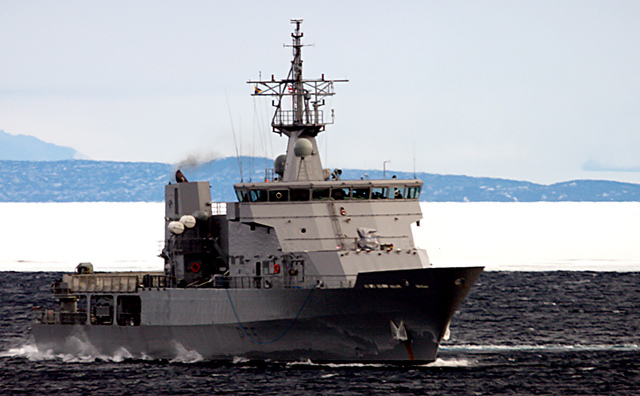
Photo Credit: MIchael Patterson
The HMNZS Wellington, a patrol vessel in the Royal New Zealand Navy, in McMurdo Sound.
Many of the replacement crewmembers for the Palmer flew to the ice with the deploying winter crew, allowing us to form new friendships, and we were treated to tours of the vessel while it was in port. Although it did not make McMurdo an official port of call, the ill-fated adventure vessel Berserk out of Norway visited the harbor to drop off a shore party near New Zealand’s Scott Base And, just a few days ago, McMurdo Station welcomed guests from the Enderby, an Antarctic cruise vessel hailing from New Zealand. After several date changes due to weather, the tour group made shore on Feb. 27 and were treated to tours of the station’s lab and store, along with visits to Robert F. Scott’s historic hut and Scott Base. Mother Nature seemed determined this month to make the summer/winter transition a tumultuous one. The entire U.S. Antarctic Program Serving as the New Zealand logistics base for USAP operations at McMurdo and South Pole At the same time we were absorbing the news of the earthquake in Christchurch, McMurdo Station was also bracing itself to deal with a bout of major storms on the home front. High winds and heavy snow mandated the calling of the first Condition 1, the designation for the most severe weather, of the winter. Some of the last remaining flights of the summer season were put on hold for several days as we waited out the storm, before we banded together to dig out from the heavy snowfall. The high winds also created big sea swells in the already open water just in front of station, causing major sections of the semi-permanent ice shelf to break free and float out to sea. 
Photo Credit: Michael Patterson
The research vessel Nathaniel B. Palmer docks at the ice pier near McMurdo Station.
This has caused the open water to encroach upon the major thoroughfare between the Ross Island research stations and the Pegasus airfield. The waves also caused damage to the ice pier that recently served as a dock for the Palmer. The pier, which was built from scratch last winter to replace a 10-year-old pier that was deemed unsafe, will have to be repaired this winter with existing supplies, as there are no materials on station to create a brand new pier at this time. The “herbie” (the name for big storms that occur on Ross Island) also apparently laid claim to the Berserk, the ship that had been spotted just a week earlier in the harbor. While the two-person shore party, which was attempting to reach the South Pole in honor of Roald Amundsen’s historical first trip 100 years ago, managed to make its way back through the storm to McMurdo Station, the ship put out a distress call during the storm and has not been located since. [See NSF article: National Science Foundation Transports Two Norwegian Expeditioners to Safety While the forces of nature and loss of life both close to home and across the sea have unsettled many people here on station, the winter-over crew is a hearty bunch and continues to carry on business as usual. About 150 of us who will remain through the dark, cold months ahead hope that February was just a crazy confluence of events and that the rest of the winter will offer smoother sailing. Emperor penguins visit McMurdo as vessel operations beginPosted February 4, 2011
Along the road to Pegasus Airfield Located just off the snow road, they have offered many people, who would not have otherwise had the opportunity, a chance to see these Antarctic natives up close. The McMurdo Recreation department has taken advantage of these conveniently located penguins to transport groups to the ice shelf during off-hours. And plenty of people have taken the opportunity to snag that perfect and very rare photograph of these beautiful animals, with smoking Mount Erebus as a backdrop. 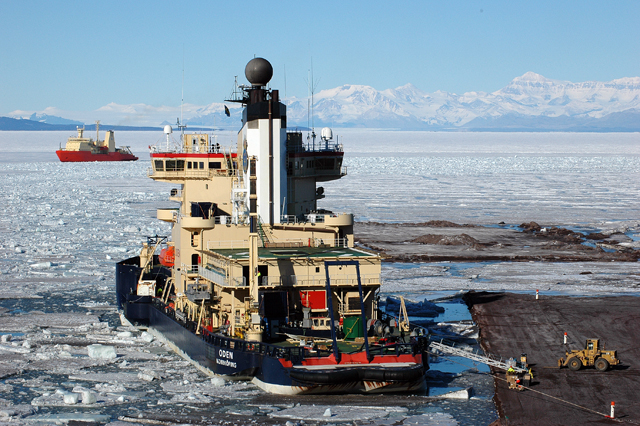
Photo Credit: Peter Rejcek
The ODEN docked at the McMurdo Station ice pier, with the NATHANIEL B. PALMER in the distance.
This diversion is much needed, as McMurdo readies for the end of the busy summer field season. The Swedish icebreaker Oden After a brief delay due to a problem with the ice pier, the fuel tanker Richard G. Matthiesen docked and offloaded about 5.3 million gallons of fuel at the end of January. Next up will be the unloading and loading of the cargo ship — a complex and highly choreographed materials ballet known in town simply as “Vessel.” Navy Cargo Handlers, referred to as NAVCHAPS, began to arrive on Jan. 31 to assist in the operation. The research vessel Nathaniel B. Palmer Science around the continent continues, though the number of field camps and people are rapidly dwindling as things start to ramp down. It’s been a very successful year at a field camp in the Central Transantarctic Mountains (CTAM), with returning science groups praising the efficiency of the camp and its staff. As the science groups departed, the Raytheon Polar Services The NASA Long Duration Balloon 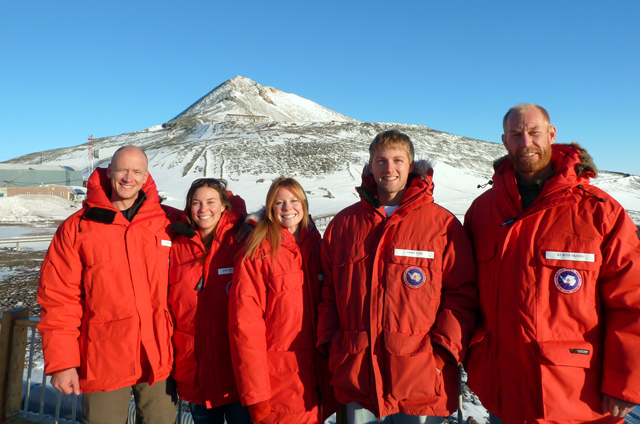
Photo Courtesy: Lindsey Vail
A Family Affair: Five family members were on the Ice together between McMurdo and South Pole stations during 2010-11. From left, Dan Scheerer, Kristina Scheerer, Adam Vail, Lindsey Vail and Kurt Skoog.
The CREAM There’s excitement at the WAIS Divide With less than a month left before the start of winter, McMurdo enters one of its hardest-working periods, with departments moving to 24-hour schedules, filled with the omnipresent sound of backing alarms on heavy machines for the massive Vessel offload — all part of the annual cycle of life at McMurdo Station. Fast-paced season ensures plenty to see and do at McMurdoPosted November 26, 2010
I take a seat in the crowded dining hall and stare out the window, past the rivers of meltwater flowing through channels in the streets carefully carved by Fleet Operations, and watch the routines of McMurdo Station Helicopters lift off past Observation Hill, hauling sling loads of gear for field camps. Science groups in snow-covered Pisten Bulleys return home from an overnight trip on the tracked vehicles. Station personnel in Carhartts walk about in the bright sunshine. Summer is in full swing on Ross Island. The Sea Ice Runway has welcomed hundreds of people since it opened in October, swelling station population to almost 1,100 even as groups have passed on to the field camps, the South Pole Some groups, such as the French Concordiasi Also leaving us this month was Antarctica’s first female chaplain, Laura Adelia, who was pinned as a lieutenant colonel upon her arrival at McMurdo. She returns to her congregation in Arizona. Science continues, however. The science team of Robert Garrott of Montana State University The penguins are looking good as well. A group led by Paul Ponganis, with Scripps Institution of Oceanography Team members are now camping out at Cape Washington, where they have successfully deployed recorders and transmitters on the penguins to help in the study of their physiological ecology. And while they have not yet seen any leopard seals, which they would like to tag for another part of their research, they have seen evidence of them. 
Photo Credit: Stacy Kim/Antarctic Photo Library
Scientists prepare to deploy SCINI through the ice into McMurdo Sound during a previous field season.
Another team is sending a remotely operated vehicle called SCINI (Submersible Capable of under Ice Navigation and Imaging) Some lucky people who are not directly connected to the scientists have had opportunities to partake in morale trips, heading out with groups into the field to assist in dive tending, or shovelling snow, or what might be a once-in-a-lifetime opportunity to go ice fishing at the base of Mount Erebus. A very tired but excited firefighter, Jeff Kennett, exclaimed excitedly upon his return from his working day trip that he “didn’t catch the most fish, but I caught the first fish, and the last fish.” Another recreational activity causing quite a stir is the return of the Observation Tube, a metal cylinder with an observation port at the bottom, which was inserted into the sea ice. It allows visitors to descend below the level of the ice and have a look around in the sea, a view that is almost always reserved for the divers. Visitors have been lining up around-the-clock for a chance for this unique opportunity, and faces flush with excitement report seeing seals swimming close by — a rare opportunity to view these animals in their native environment. Next up for McMurdo is Thanksgiving Dinner, coming up on Saturday, Nov. 27. The kitchen crew puts everything on the line for this, the most anticipated meal of the season. It’s a chance for the cooks to showcase their abilities and talents and to shine for the community. From my seat at the dining hall window, I’ll watch as the unwary with blue trays full of delicious leftovers try to dodge the opportunistic skuas. Field camps start to pop up as ice pier work continuesPosted October 29, 2010
Scientists and support personnel continue to pour into McMurdo Station The largest field program in the early part of the season is nearly complete. The French-U.S. Concordiasi project A group from the University of Wyoming Meanwhile, nearly 50 people are in eight field camps near McMurdo Station. Science teams include researchers studying the population dynamics of Weddell seals from a location called Big Razorback and divers studying a strange microbial ecosystem in an ice-covered lake in the McMurdo Dry Valleys In town, work continues on a new ice pier when the previous structure unexpectedly cracked and separated at the end of the 2009-10 summer season after all the vessels had departed. McMurdo Fleet Operations developed a technique to relocate the broken pier using the wind and tide for controlled drifting so work could begin this past winter on a new pier. The ice pier is a one-of-a-kind creation — essentially a huge, steel-cable-reinforced, floating ice cube. It was built for the first time at McMurdo in 1973 by the U.S. Navy. Six piers have been built since then. The latest had been in operation since 1999. [See story in Jan. 8, 2006 issue The pier accommodates the annual cargo re-supply vessel and a fuel tanker, along with icebreakers and research vessels. The USAP will continue its push to become more energy efficient this season with the testing of two electrical vehicles around McMurdo. Last season, in collaboration with the Antarctica New Zealand McMurdo Station throws open the doors to summerPosted September 24, 2010
Busy is the one word that could be used to describe August at McMurdo Station With a final wave to winter came a bevy of greetings. Hello to the sun, hello to a new U.S. Antarctic Program The first flight of Winfly, short for “winter fly-in,” arrived Aug. 15. It was notable because it marked the first ever night-vision-goggle flight involving passengers. Over the last two years, the U.S. Air Force has flown several practice night flights to prove that the large C-17 Globemaster III planes can be used safely to move passengers and cargo at any time of the year. [See related article: Night vision.] More than a week earlier than years past, the flight kicked off one of the busiest Winfly periods in McMurdo history. Traditionally, Winfly consists of a small number of flights in late August to bring in extra supplies and people to help de-winterize the station and prepare for the summer season. This year, however, seven flights over two weeks brought 400 new support personnel and scientists, and about 400,000 pounds of cargo. The population swelled from 198 — people thrown together for six months of winter isolation — to 526 people. The max population in summer is about 1,100 at McMurdo. The winter crew did much of the job de-winterization the buildings — cranking on the heat, troubleshooting furnaces — in late July and early August. That allowed the fresh crew to hit the ground running to support some logistics-heavy science during the late Antarctic winter. This Winfly there are three projects involving more than 30 National Science Foundation 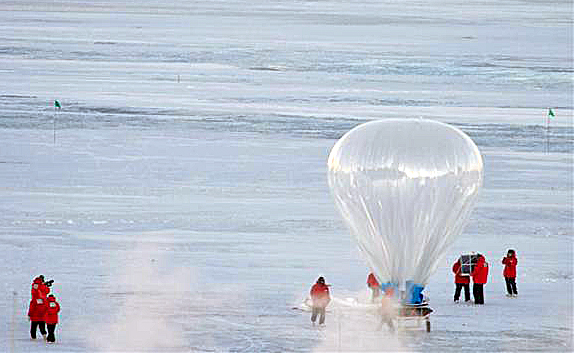
Photo Credit: Holly Troy/Antarctic Photo Library
Scientists launch the first Concordiasi balloon from the sea ice near McMurdo Station.
The research during Winfly ranges from atmospheric measurements to monitoring seal behavior. The biggest science group represents the Concordiasi project Their research consists of deploying multiple large balloons high into the air that carry instruments that measure the troposphere and stratosphere, the lowest two levels of the atmosphere. One main goal is to validate data already collected from a polar-orbiting satellite by calibrating it with the data collected from sensors on the balloons. Other balloons will carry instruments to study the role of nacreous clouds in ozone depletion. These high-elevation clouds only form in the extremely cold temperatures found during the Winfly season, and fill the sky with streaks of color rivaling any sunrise or sunset. About 18 balloons will be launched from a camp very close to station, allowing McMurdo residents to get a firsthand look at science at work. [See related article: Flying high.] Terry Deshler’s Finally, back for a third season, is a group of researchers studying the diving and hunting patterns of Weddell seals in low-light conditions. Given that Winfly still has periods of sunlight and darkness, this is the only time that this research can take place at McMurdo short of spending the winter. The team has already successfully caught five of nine planned seals. They collect individual biological data on the animals before securing monitoring cameras to their backs to further study their habits after release. [See related article: Night hunt.] Weather has once again played a major role in Winfly operations. While it is a much proven fact that weather on Ross Island is at its worst during the months of August and September, it is still impossible to predict exactly how or when this bad weather will manifest itself. This year brought near-record snowfalls, high winds and cold temperatures. A storm on Aug. 25 dumped 6 inches of snow in a 24-hour period, nearly beating the decades-old record of 6.2 inches set in 1966. The lowest recorded temperature for August was minus 71 degrees Fahrenheit with wind chill. While not a record, the storm did wreak havoc on the flight schedule, causing multiple delays, as we waited for the snow and winds to calm down, and for the heavy equipment operators to clear the runway and roads to the airfield. Despite the challenges of weather, everyone has managed to work around these setbacks to prepare for the onslaught of summer. Olympic curling comes to McMurdo StationPosted August 27, 2010
McMurdo Station A chili cook-off pitted local chili masters against one another, with the blue ribbon going to Pat Gilmor from the supply department. Dining hall staff provided a bevy of familiar carnival foods, including corn dogs and funnel cakes, and there was even cotton candy provided by the UT Shop from the very first Antarctic cotton candy machine made from old parts. In yet another tradition, winter-overs donated items and services for an auction to benefit the community. The proceeds go to purchase winter hats and T-shirts designed by local artists, as well as for door prizes and beverages for the end-of-season winter party. In a wonderful act of charity, station manager Jeanne Suchodolski pledged to match all auction profits in a donation to the Red Cross. The evening wrapped up with live music from many of the winter bands, and revelers danced late into the evening. Although fireworks are not allowed on continent, research assistant Jason Bryenton organized a special firing of the Lidar laser into the night sky, as a close second to this great American tradition. Not to be outdone by the Fourth of July, store manager Keri Nelson, along with a group of dedicated volunteers, organized a street fair that was held outside of the store in the station’s main building one Sunday afternoon. The street fair was coordinated with the store’s end-of-season sale and included jugglers and other buskers, appearances by local “celebrities” handing out autographs, a live radio show, and many arts and crafts stalls highlighting the work of local artists. Even though it took place in a hallway, the volunteers managed to capture the feeling of a busy street market, and everyone had a great time. July also featured the unveiling of the first-ever curling rink in Antarctica. Designed and built by volunteers over the winter, the scaled-down version of a standard curling rink now exists outside next to Gallagher’s pub. Complete with curling stones and brooms, the inaugural match brought out many residents to learn the secrets of this mysterious sport in which players slide stones across a sheet of ice toward a target area. Several McMurdo teams competed for the honors of representing the station in the first-ever international Antarctic curling championship against New Zealand’s Scott Base After an afternoon of raucous play, including a hot cocoa break at the half, McMurdo claimed the right as Ross Island curling champions for this winter season, with a final score of 8 to 4. The month wrapped up with an end-of-winter bash. Held in multiple locations across the station, the party was organized to allow winter-overs to enjoy each other’s company in a relaxed yet festive atmosphere one last time before the influx of new people during the Winfly season. The evening’s festivities included a beer tasting of New Zealand brews, finger foods provided by the kitchen staff and a variety show featuring poetry, stand-up comedy, skits and music. All of this, and we managed to prep the station for an early August arrival of scientists and support crews during that time between summer and winter seasons known as Winfly. Dorms and other buildings that had been winterized all season have been re-heated and opened for business to meet the demands of the 400 new residents who began arriving Aug. 15 when the first flight touched down at Pegasus airfield We have lost the peace and quiet of winter, but the payoff is the arrival of old friends and fresh faces — and all of those delicious fresh fruits and vegetables. McMurdo residents shake it up for youth educationPosted July 23, 2010
For a slow month, June managed to creep up on McMurdo Station 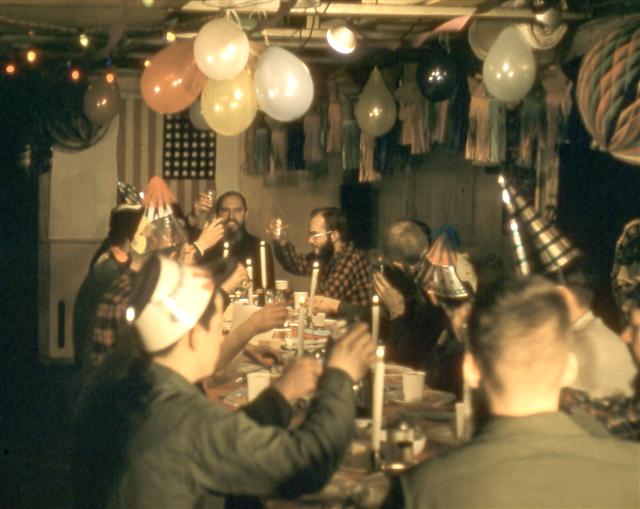
Photo Credit: Cliff Dickey/Antarctic Photo Library
Men at the South Pole Station celebrate Midwinter Day with a feast in 1957.
The Midwinter celebration is a holiday unique to those wintering at bases on the Antarctic continent and the subantarctic islands. Held on June 21, the day of the winter solstice, Midwinter celebrates the completion of the first half of the winter season and the start of the slow return of the sun. At McMurdo Station, the highlight of the celebration is a night of fine dining and dancing, taking place in the decoratively transformed dining hall. Residents helped in all areas of preparation, including decorations, music, photography, food preparation, dishwashing duties, volunteer organization, and setting up and breaking down the dinner festivities. The night commenced with appetizers, as folks gathered to nibble on the hors d'œuvre and sip on wine, served by volunteers. Serenaded by the musical stylings of Fleet Ops’ own Jason Barcomb, it was a chance for people to mingle and appreciate their co-workers dressed in their finest attire. As always, the kitchen staff outdid themselves with the dinner offerings. A selection of cold salads included a buffet of fresh vegetables from the greenhouse, as well as cold duck breast salad on toast. The main entrees had something for every palette, including Beef Wellington, stuffed lobster tail, and a delectable veggie entry. Desserts were a work of art by master baker Josie McLeod — pyramids of chocolate mousse, platters of hand-dipped truffles in every flavor, puff pastries with cream, and even homemade ice creams and sorbets. Dinner was followed by dancing and revelry, as McMurdo residents took a moment from their busy work schedules to enjoy the company of their fellow winter-overs and celebrated the passing of darkness into light. However, Midwinter celebrations did not cease with the end of the music or the transformation of the elegant dining hall back into a kitchen galley. The festivities continued the next weekend with the annual midwinter run. Although only a brief 1.4-mile course, the race is a tradition that brings with it the rigors of winter. Racers must dress for unpredictable winter weather and navigate the all-dark course with the help of flashlights and headlamps. A long-held tradition, the race signifies the winter-over spirit and the commitment to not just sit dormant while the sun is below the horizon. This year’s race brought out about 11 volunteers and 22 hearty souls of all abilities for the 10 a.m. start. The final results had Matt Cherf (Fuels department) as the overall male winner with a time of 9:05 and Cathy Morrell (UT shop) as the overall female winner with a time of 9:42. Whether fast or slow, running or walking, all the participants enjoyed the opportunity to get outside and compete under the stars. The passing of midwinter means that we have gone about five months without mail. However, McMurdo residents were treated to package deliveries courteous of the U.S. “Penguin” Service. Interested folks signed up and created anonymous packages filled with goodies found in their rooms or in "skua," the local depository for items that people no longer need but are still useful. Packages were “mailed” over a two-day period, and then received from the recreation office. Package mail items ranged from hand-knit hats, fancy chocolates and other food items, toys and other gag gifts. It was a great treat to receive and open mail in the middle of the winter season. 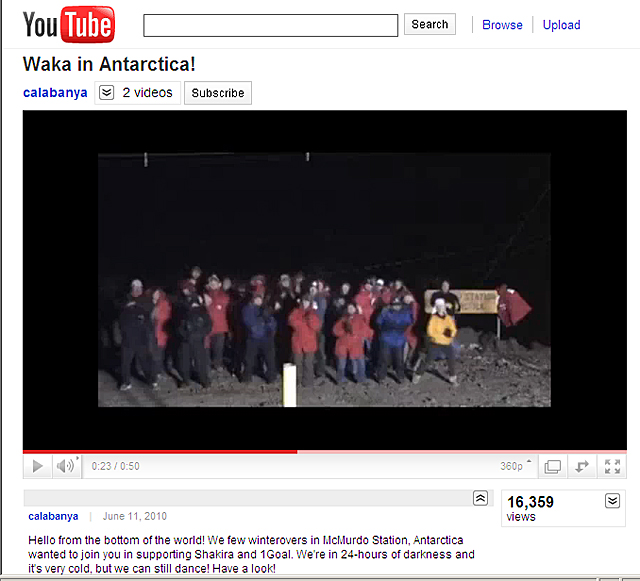
Screenshot of YouTube video showing McMurdo Station residents dancing to Sharkira's song "Waka Waka - Time for Africa."
Although far away from most of the current events of the rest of the world, McMurdo residents were bitten by the World Cup bug as well. Using a random-number generator, each resident on station was assigned to one of the teams participating in the soccer matches. Having a particular team to root for made following the games all the more exciting. Games were broadcast both on the regular TV channels and also shown in lounges and bars where larger groups could gather. Due to the time difference, some diehard fans were meeting as early as 6:30 am to watch some of the key matches. The group assigned to the winning team were awarded prizes from the recreation office. Along with following the different national teams in the soccer competition, a large group of music and dance lovers participated in the 1Goal: Education for All The group recorded and uploaded a video of themselves to YouTube Being the only post from Antarctica, the YouTube video garnered a great number of hits (16,000 and counting), and even received special comments from Shakira herself. Winter mixes recreation and work at McMurdo StationPosted June 11, 2010
May came in fast — and passed by even faster here at McMurdo Station Auroras have begun painting the sky with a dancing array of colors, and the Southern Cross dutifully points south on clear days, reminding us just where to look when giving a nod to our South Pole This month brought many opportunities for us to mingle with our Kiwi neighbors over the hill at New Zealand’s Scott Base 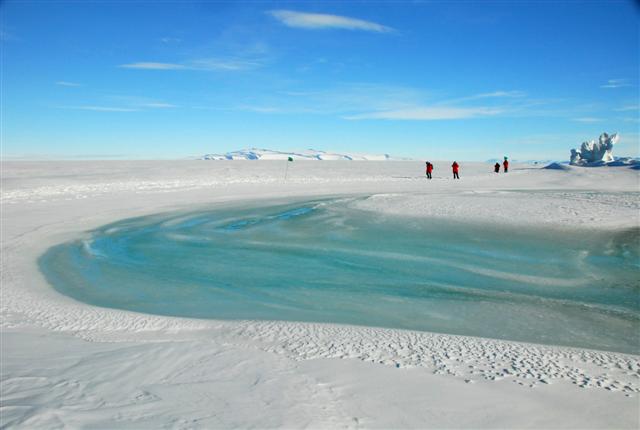
Photo Credit: Robyn Waserman/Antarctic Photo Library
The area off-shore New Zealand's Scott Base has pressure ridges and open water where the permanent ice shelf pushes up against the shore ice.
At the end of April, McMurdo residents were invited to a ceremony at Scott Base to commemorate ANZAC day — the New Zealand alternative to Memorial Day, which honors New Zealand and Australian military that served and died at Gallipoli, Turkey, as their first major action during World War I. This is an important national celebration, and it was an honor and a privilege to help them celebrate such a sacred day. In a more celebratory fashion, there was a strong Kiwi contingency at McMurdo Station for the station’s inaugural beer-tasting festival. The tasting featured eight beers and one cider, which were all brewed in New Zealand. These beers, which are not available for purchase in the McMurdo store, were a treat for all and an opportunity to once again experience a piece of New Zealand culture. Festivities continued throughout the month with several themed parties, including the Famous Dead People’s Ball and the Space Party. The Dead People’s Ball has become an annual tradition at McMurdo Station, where people dress up as someone who is both famous and dead, and each year brings some radical costume ideas. The Space Party, held at Scott Base with an intergalactic theme, featured live music from some of the multiple bands that have formed this winter. With a large pool of talent this season, the bands covered all genres, from original rock to country, and played late into the evening. While everyone on station found plenty of recreational opportunities to stay busy during off-hours last month, plenty of time was spent on topics of a different sort. Preparation and planning to refine our Comprehensive Emergency Management Plan (CEMP) continued to be a station-wide effort. The winter-over population came out in full force to take on a challenge by station management to bring our preparedness to a new level. When asked to put in the time commitment to complete Incident Command System (ICS) training courses offered online by the U.S. Federal Emergency Management Agency The inclusion of ICS and the appropriate training is a mandatory part of the mass casualty plan, as set forth by the federal government; however, completing the training was done on a voluntary basis. The fire department has also begun offering CPR and First Aid training classes twice a month. 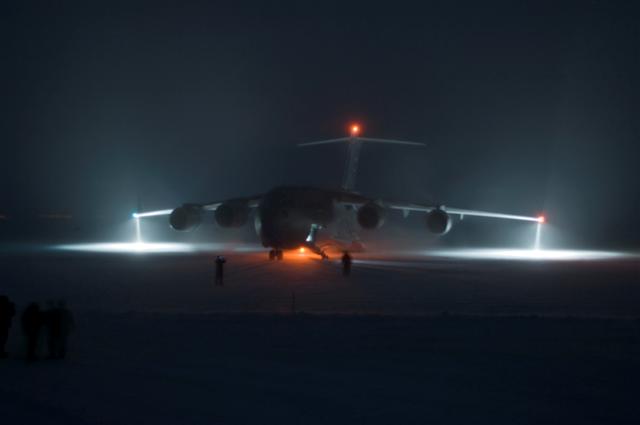
Photo Credit: Bill Henriksen/Antarctic Photo Library
An Air Force C-17 Globemaster III at Pegasus Airfield in August 2008 after the first successful night-vision goggle mission on the Ice.
With May behind us and June fast upon us, the days are moving quickly for this winter-over population. Just recently, we learned that Winfly, the period when the first wave of flights arrive, will begin on Aug. 13. That’s about a week or so earlier than normal, necessitating the use of night-vision goggle missions by the U.S. Air Force out of Joint Base Lewis-McChord This announcement brought with it both joy and trepidation, as everyone took stock of how fast time is moving. In just over two months, old friends and new ones, in a flurry of action and summer preparedness, will greet us. Whether we look forward to the influx of new faces or are looking for the best place to hide, one thing remains certain for all who are wintering: The end is in sight, and we can begin making travel plans! Good neighbors and good times over the hill at Scott BasePosted May 14, 2010
April 27 marked the final sunset over McMurdo Station However, although the sun has officially disappeared from view, long twilight continues to fill the sky with color and paint the mountains of the Royal Society Range across McMurdo Sound with pinks, oranges and golds. The daylight hours are decreasing rapidly, and months of darkness will soon wrap McMurdo but not without one last vision of nature’s beauty. The final sunset was celebrated by all with a sunset posted hosted by New Zealand’s Scott Base 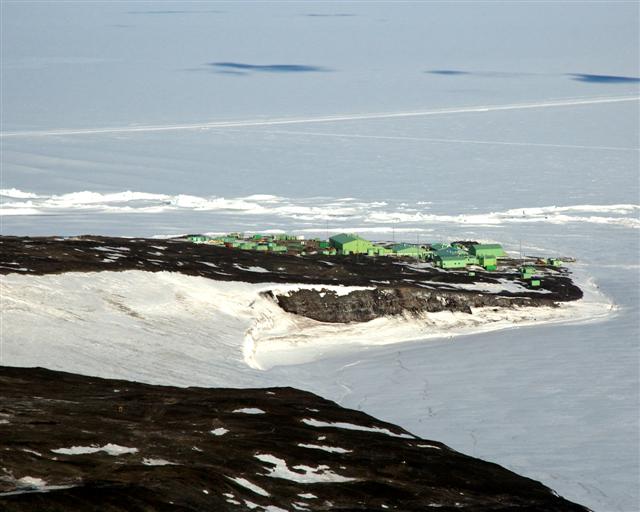
Photo Credit: Timothy Russer/Antarctic Photo Library
Scott Base, home to the Antarctica New Zealand program.
Along with the inevitable slide into darkness, April also brought with it a McMurdo Station first: the inaugural Store Fashion Show, put on by store manager Keri Nelson and a large crew of creative volunteers. Highlighting the works of fictional designer “McMurdo,” the evening event showcased an array of new items that arrived on the annual resupply vessel in February and that will be available for purchase in the station store over the next several months. All the stops were pulled to put on this gala affair, with video productions, “on-scene” media reporting live from the red carpet, and over a dozen volunteer models showing off hats, T-shirts, sweatshirts and other souvenir items. The creativity and hard work of many winter-overs went into making this a night to be remembered — and hopefully a night to be repeated in years to come. McMurdo Station winter-overs enjoyed a two-day weekend last month as well. The normal weekly work schedule runs from Monday through Saturday, with only one day off each week. However, the winter schedule allows for one full weekend a month for workers to relax and recoup, as a way to compensate for the many holiday weekends that are overlooked due to the load of winter tasking that must be accomplished. Once again, much of the community celebrated picnic-style at the Vehicle Maintenance Facility, as they enjoyed barbeque, chili, and a double-elimination horseshoe tournament that took up most of the day. This is a fine way to spend a relaxing day with friends. 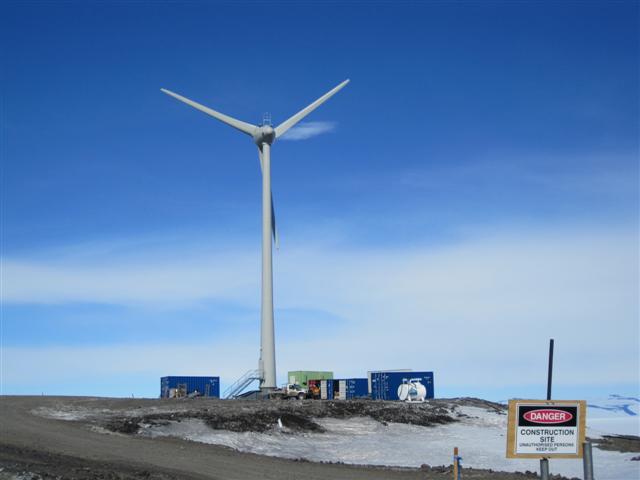
Photo Credit: Chris Wilson/Antarctic Photo Library
One of three wind turbines shared by the U.S. and New Zealand Antarctic programs for power generation.
Winter-overs have also begun to develop new friendships with our neighbors over the hill at Scott Base. Located just three miles from McMurdo Station, the New Zealand base offers McMurdo winter-overs an opportunity to make international friends, as well as a place to escape for a bit of a change. Relations with the members of the Scott Base community are always close, with the two stations sharing power-making capabilities and other operations. In the winter, the smaller community size allows for more mixing and mingling on a social basis as well. Along with being frequent participants in the social events at McMurdo Station, every Thursday, the Kiwi base — ironically enough, only populated by four New Zealanders out of the 13 base members this winter — hosts “American Night,” for members of the McMurdo community. Each week a small group joins the Kiwis for a delectable dinner in their galley, and then the base store and lounge are opened up for the whole McMurdo community to visit for the remainder of the evening. This is a wonderful chance for members of both communities to meet and share stories, building friendships that will last well beyond the confines of winter. McMurdo Station winterized and ready for the long nightPosted April 23, 2010
On March 5, 2010, the final flight of the 2009-10 summer season left McMurdo Station 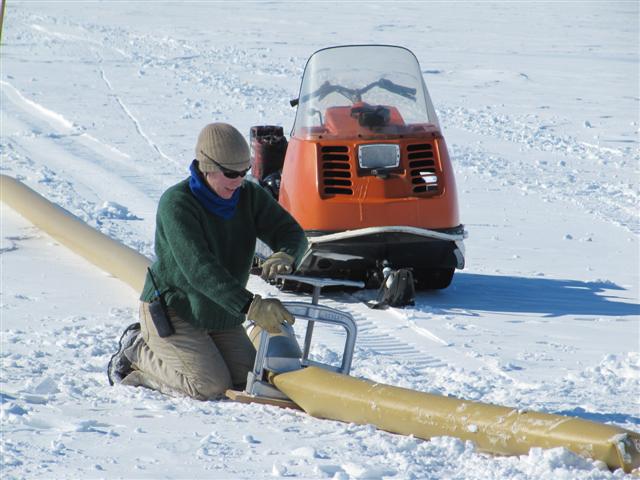
Photo Credit: Jennifer Kemper/Antarctic Photo Library
Fuels operator Lisa Keller clamps a fuel line that runs to Pegasus Airfield.
The primary goals of this extended season were to roll up the nearly 14 miles of fuel line stretching from the station to Pegasus Airfield After waving goodbye to the final flight, the remaining 198 winter-over personnel got to work. Standard winter tasking is moving along rapidly, with many departments working hard to collect, inventory and repair all the materials needed for summer science. For example, the staff at the Berg Field Center, a science support center responsible for all materials issued for living and working in summer field camps, will spend the winter carefully inspecting tents, stoves, sleeping bags and other field materials to make sure that they are ready to issue to scientists upon their return. In turn, the mechanics at the Mechanical Equipment Center, another science support center, are moving through their winter tasks: performing preventive maintenance and repairs on bigger items such as skidoos, field generators and heaters. Recreational activities are at full blast, thanks in part to the addition of a winter recreation coordinator this winter. We celebrated St. Patrick’s Day with a four-mile Leprechaun fun run in the morning, kicked off by the appearance of Fire Capt. John Cassidy dressed as a leprechaun. The day ended with an Irish-themed party in the evening, complete with bagpipes. 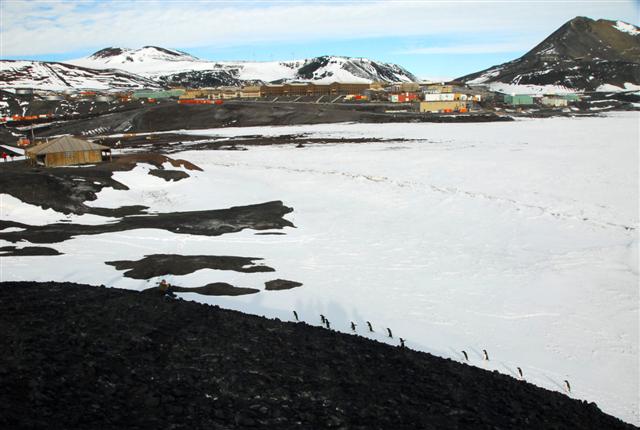
Photo Credit: Robyn Waserman/Antarctic Photo Library
A line of Adélie penguins is spotted near McMurdo Station in January 2010.
The annual wine tasting was also a success, offering winter-overs the opportunity to meet and mingle while sampling vino from New Zealand. Held each year in the library, the tasting featured community musicians and fine foods provided by the dining staff. There is a strong focus on health and wellness this season. In addition to the standard yoga and Pilates classes, more unique offerings include fencing, international dance, Zumba and poi spinning. Zumba, a cardio class that mixes Latin dance moves with cardio exercise, is a popular class, meeting twice a week and drawing a very diverse crowd of followers. To help people create and meet their own personal health and fitness goals, various groups have formed to support weight loss and fitness advances. McMurdo’s version of the popular TV challenge “Biggest Loser” attracted almost 15 percent of the population, with 27 people competing to lose the largest percent of weight during the eight months of winter. The McMurdo Fitness Club includes some of the “Biggest Loser” participants but also involves many people looking to improve their physical fitness without a weight loss component. In keeping with the focus of station wellness, training began this month for Mass Casualty Incident (MCI) preparedness. An MCI is any emergency event that may occur on station that would tax the resources of the full-time emergency team, which consist of the medical staff and the fire department. In the event of such a major emergency, volunteers would assist in all areas of response, such as stretcher-bearers or on the trauma team. Teams have met for individual training and organization, and will come together frequently over the winter to run through drills. Currently, there are 88 winter-overs training to be ready to serve the community. Days are getting shorter as the final sunset in April fast approaches. Winter-overs are taking the time to enjoy the last vestiges of the Antarctic daylight with recreational trips for prime sunset viewing. Soon, the sun will set, the stars will be out, and the ghostly Aurora Australis will appear — a spectacle to keep drawing us outdoors until the sun reappears in August. McMurdo Station bids farewell to last summer flightPosted March 19, 2010
“Wheels up on the last flight!” bleeped the radios, and soon the Australian Airbus flew close enough to McMurdo Station 
Photo Credit: Wally Walker
The last flight of the 2009-10 season leaves Antarctica on March 5, 2010.
Whoops, cheers, (tears?) followed the plane into the blue from the 70 or so people gathered for the send off. Then came looks — hard looks — around as the realization hit: these are the furry faces, the windblown cheeks and runny noses we’ll be seeing for the six months. After the March 5 flight, there will be no more flights to McMurdo Station until August. The final tally on the winter population, according to Karen Robinette of Human Resources, shakes out to 198 people. Forty-seven women and 151 men. This will be the first Antarctic winter for about a third of the population, while more than 60 percent weathered winters before. Three dormitories are open to accommodate the population, with pleasant perks like wireless Internet and having one’s own room — unheard of in the crowded summer season. No longer are there lines for computers or laundry, and you don’t have to look both ways before crossing “Highway 1,” the central hallway in the station’s main building. Dining hall lights are dimmed to natural light only, a setting called “winter lighting” as the station ekes out what’s left of the sunshine before darkness takes hold April through August. But while life has quieted, the work pace keeps cranking along. 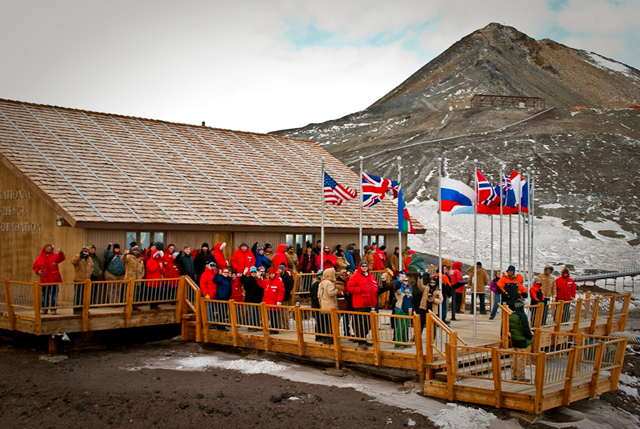
Photo Credit: Wally Walker
People at McMurdo send off the March 5 flight from the deck of the McMurdo Station chalet.
According to Station Manager Jeanne Suchodoski, key winter tasks include the repair and return to service of machinery in preparation for the summer science season. Receiving inventory must be completed after February’s weeklong cargo vessel offload. The heat trace project, funded by $3 million in stimulus money, continues to work on installing thermostatic controls along six miles of pipeline to keep water from freezing. The $5 million Mogas (motor gasoline) upgrade will continue to rebuild the fuel system with the hopes of doubling the station’s fuel capacity in case of a failed ship re-supply. Another preventive project is the power plant upgrade to add redundancy to the current system — where a failure can mean shutting down a portion of the station. The new power plant will also capture more heat and use less fuel, according to the National Science Foundation Office of Polar Program’s Hard work in the cold means hearty appetites, and special attention was given this year to keeping McMurdo’s greenhouse operating and ensuring imported fresh food stays around longer. According to Kitchen Supervisor/Chef Justin Lardy, the dining hall ordered 660 pounds of waxed apples, 210 dozen eggs, and fresh cream, which can last four to six months. In the event more people enjoy that cream over apples, McMurdo is offering its own version of the “Biggest Loser” weight-loss competition. However, girth and growth are encouraged in the winter’s traditional mustache growing contest. What’s an Antarctic winter without a lot of furry faces to look at? End-of-season ops under way at McMurdo StationPosted February 5, 2010
The rumor raced through McMurdo Station This, alas, was a hopeful wish born of Attenborough’s mid-month visit, though it wasn’t long before the legendary man held court on birds-of-paradise and other adventures during a presentation to a packed crowd of star-struck wildlife lovers. Attenborough was in Antarctica for a new BBC/Discovery documentary series called Frozen Planet, which focuses on the polar regions. [See previous article: Frozen Planet.] 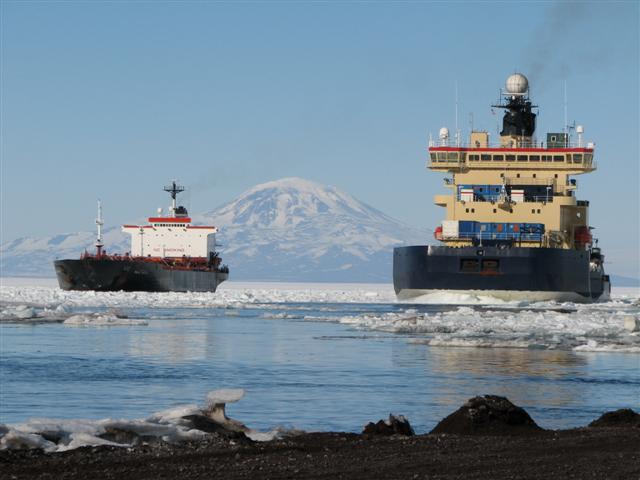
Photo Credit: Chris Demarest/Antarctic Photo Library
The Swedish icebreak Oden clears a channel for the MV Paul Buck fuel tanker ship.
Wildlife lovers had a great month all around, as open water in front of McMurdo brought penguins a plenty to town. Whale spouts were visible from bayside windows, and four Adélie penguins even crossed the finish line along with 67 participants in the annual marathon race on the ice shelf. Swedish icebreaker Oden appeared on the horizon in early January and cut wide swaths in the sea ice, creating a channel for the MV Paul Buck tanker ship that arrived for a fuel delivery. The tanker brought 4.6 million gallons of AN-8, 350,000 gallons of JP-5, and 115,000 gallons of MOGAS, according to the Fuels Department. The offload took about 38 hours. The cargo vessel, which carries most of the food and materials for McMurdo and South Pole The station population continued to fluctuate as field camps began breaking down and closing for the season, and winter-overs started trickling in to prepare for the long, dark night. Warm weather blessed annual Icestock music festival, as 16 bands rocked the stage — outdoors in front of happy hula-hoopers, robots, ninjas and regular folk — and indoors to packed, energetic dancers. Another lovely warm day set the annual McMurdo/Scott Base Weather didn’t matter for Freezing Man — McMurdo’s answer to the Burning Man festival in the Black Rock Desert of Nevada. The party included dancing, various performances and costumes. Nor did weather matter for the McMurdo Film Festival, which held the crowd rapt with films like “The Beauty of a Harsh Continent” and “Pizza.” McMurdo residents catch some rays as summer heats upPosted January 8, 2010
Brats sweated on a charcoal grill. Batters took their practice swings and fielders tossed the ball around. A megaphone-wielding janitor kept a running patter for the fans. A typical summer scene — except for the baseball mitts stuffed with hand-warmers and the ballfield of volcanic rock. Scores of people played ball at McMurdo Station’s 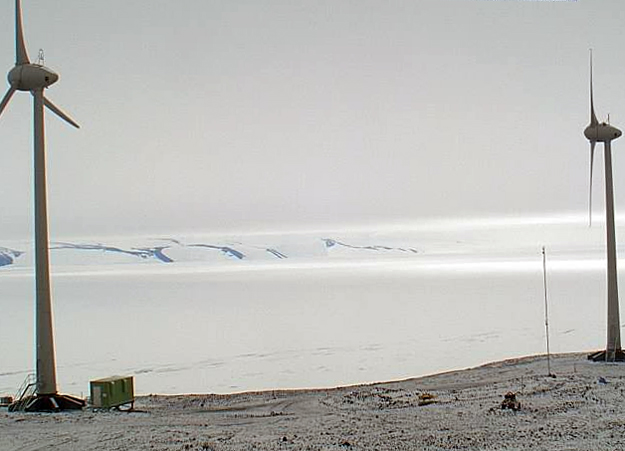
Photo Courtesy: Meridian Energy and Antarctica New Zealand
A Webcam shows two of the three new wind turbines near McMurdo Station.
Folks cruise around on bicycles with skis strapped to their backs or squeeze in rounds of Frisbee golf. In just two days over the Christmas holiday, some 60 hikers took to the Cape Armitage and Castle Rock trails. Another 15 skied 13 miles back from the Pegasus air field Warmer weather brings significant changes to the local landscape, as the Scott Base Adélie penguins skirted the station around Hut Point on Christmas. Other visitors this month included a group of 108 cruise ship tourists who stopped at McMurdo Station during a month-long voyage on the Russian icebreaker Kapitan Khlebnikov. The international tourists rode by helicopter to McMurdo, received a tour of the station and visited nearby Scott Base. The station also got a lesson in conservation Dec.19 when bars closed early and residents unplugged their coffee pots, refrigerators and computers for a five-hour maintenance on a diesel power generator. Said FEMC Maintenance Manager David Zybowski, “The load shedding went better than expected.” Three wind turbines are also spinning away on Crater Hill in a multi-national project between Meridian Energy and Antarctica New Zealand McMurdo population swells with flight delays, busy seasonPosted December 11, 2009
The iconic drawing showed men — grizzled and cramped — hanging their socks in a tent, stacked like human cordwood on an arduous turn-of-the-century expedition. 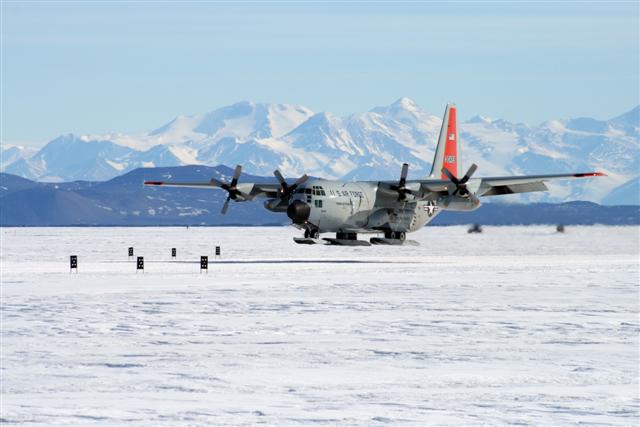
Photo Credit: Carlie Reun/Antarctic Photo Library
A ski-equipped LC-130 lands on a newly constructed skiway at Pegaus airfield, moving the USAP closer to consolidating all flights to one airfield.
While today’s McMurdoites hardly contend with the discomforts common in the “Heroic Era of Polar Exploration,” grizzled and cramped were apt descriptors of McMurdo Station McMurdo swelled to 1,121 people on Nov.17, as frequent weather delays cancelled field camp and South Pole flights while incoming airplanes from Christchurch kept crowding in. “In general, it felt chaotic and crazy, just the fact that you knew that we were at capacity maybe added to the claustrophobia a bit,” said janitor Nikki Beard. “But we also knew it was just temporary.” It was the opposite for westward field camps, as sparse put-in crews plowed through the weather delays. The WAIS (West Antarctic Ice Shelf) Divide For the first time in many years, Siple Dome camp will house 15 people and a science project to help the POLENET But new faces didn’t translate into new interest in McMurdo’s annual beard growing competition. Though this month’s Mustache and Turtleneck Party did blip on the facial hair radar, the bearded consensus shied away from the contest’s mandatory shave down. Few wanted to part with their Antarctic grizzle, which looked remarkably like the Antarctic grizzle of Shackleton’s time. This era was the focus of professor Julian Dowdeswell’s riveting talk on the “Heroic Age of Polar Exploration,” featuring favorites like Robert Falcon Scott and Ernest Shackleton. Historical photos, drawings — like the one of hanging socks — spiced up the presentation, including one drawing of three ships in McMurdo’s bay. This was the heroic era equivalent to McMurdo at mainbody in early October, Dowdeswell said. Frequent Adélie and emperor penguin sightings near McMurdo filled up snap-happy folders on McMurdo’s shared network, as dedicated volunteers spent weeks getting people out on field trips to ice caves and Cape Evans. Pictures also piled up of the Scott Base pressure ridges, and a recent group saw a seal mother and pup in the ice sculptures. Sea ice trips are winding down as the roads soften and open water inches closer to McMurdo. The Thanksgiving holiday started with a calorie-burning event — a steep 5K Turkey Trot to Scott Base — but quickly devolved into caloric gobbling as the dining hall whipped up an extraordinary feast. By the numbers: McMurdo ate 1,110 pounds of turkey, 1,500 dinner rolls, 2,200 truffles and 400 chocolate mousse skuas. Aussies make guest appearance at McMurdo StationPosted November 6, 2009
Mainbody is fully on at McMurdo Station 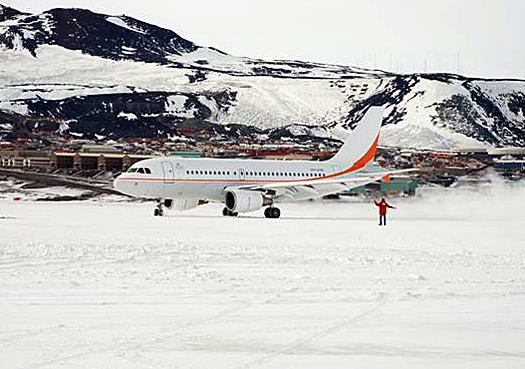
Photo Credit: Ralph Maestas/Antarctic Photo Library
An Australian Airbus first landed at McMurdo Station in 2007 during a test run.
Fifty Australians arrived on Monday, Oct. 26, from Hobart, landing on the Sea Ice Runway Also newly reopened is the craft room, which lost its home in Building 63 last year. A former smokers’ lounge in building 155 now houses craft supplies and sewing machines. The sewing machines were dusted off just in time to be used for Halloween costumes. The Halloween party actually fell on Halloween this year, capping off a week of activities including scary movies, a pumpkin decorating contest, Zombie Walk and a talk by station physician Dr. Ken Iserson, based on his book, “Death to Dust: What Happens to Dead Bodies.” Dr. Iserson is currently preparing for the stationwide mass casualty incident (MCI) drill, currently scheduled for the afternoon of Nov. 12. The drill and the team rely on non-medical station personnel with specialized training or a willingness to help to serve as recorders, stretcher bearers or auxiliary medical care providers. Volunteers are preparing to lead trips out on the sea ice to the ice caves and the historic hut at Cape Evans. Visitors to the hut will be able to get a firsthand glimpse at the restoration work being performed this summer by teams from the United Kingdom Antarctic Heritage Trust and New Zealand Antarctic Heritage Trust 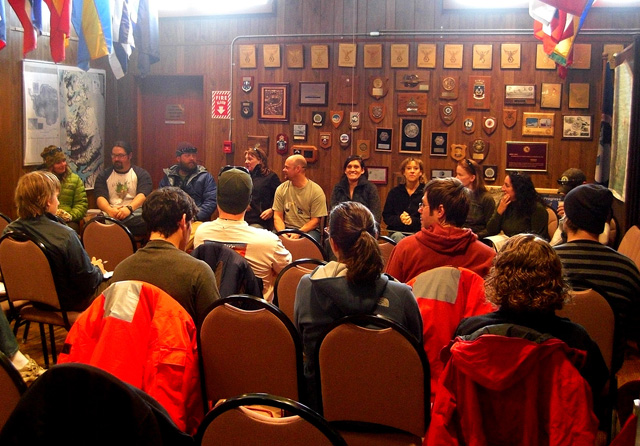
Photo Credit: Emily Goehring/Antarctic Photo Library
Newly arrived scientists receive a briefing on what to expect during their stay at McMurdo Station.
McMurdo Station is currently supporting 17 different science groups in town and in the field. October’s Sunday science lectures provided a look at Antarctic microbes, and discussions about what Antarctica can teach us about potential life on Mars. The final lecture of the month focused on the South Pole Traverse, whose participants drive more than 1,000 miles to deliver fuel and other supplies to the South Pole, and return carrying waste products. [See related article: Traverse on track.] However, the highlight of the lecture circuit was again the ongoing BBC/Discovery film project based out of McMurdo. The film team showed footage taken this year and last from around the continent. [See related article: Frozen Planet.] Dave Desautels, a foreman in the Vehicle Maintenance Facility, was named employee of the month at the October All-Hands meeting. He’s credited with helping support Fleet Ops during construction of the sea ice runway. Flying in this month, among arriving personnel, science cargo and freshies: much-missed food items such as tater tots and jalapeños, and treats for the upcoming holidays including lobster tails and crab legs. Anyone sending mail in October faced some difficult choices at the mailroom counter: first-class stamps with images of Hawaiian surfers or postcard stamps with polar bears. Summer field season under way at McMurdo StationPosted October 9, 2009
The summer field season is finally under way at McMurdo Station Winfly, the short period between winter and summer, is essentially over for the 472 folks at McMurdo. The local Channel 7 Transportation Network is listing bag drag times and flight information, meaning soon-to-depart winter-overs are busy packing up their rooms and daydreaming of coming vacations in tropical places. Actually, McMurdo Station’s isolation was already briefly interrupted on Sept. 21, when a New Zealand Air Force Hercules C-130 arrived on a medevac mission to transport a station services worker experiencing heart problems to Christchurch. The story earned a few headlines in New Zealand and the United States. The mission was a success, and the person is receiving treatment in New Zealand. Speaking of flights, Fleet Ops had been hard at work preparing the annual sea ice runway not far from town. Community members have been watching the seemingly endless, circling parade of heavy equipment spouting clouds of snow into the air to prepare a landing strip. Multiple departments have been bustling in order to find incoming folks places to live. And despite duties in both occupied and unoccupied buildings, the housing department still managed to field the winning team — Team Diesel — in the Winfly Dodgeball Tournament. 
Photo Credit: Lori Gravelle/Antarctic Photo Library
Heavy equipment operators work to remove snow and smooth a runway on the sea ice near McMurdo Station.
Crews have also been working to end the run of short power outages in town, and while the generators are being worked on, station management is also soliciting ideas for reducing energy consumption in work centers and dormitories. One person whose batteries never run down is Kai Scott, a winter-over recognized as McMurdo’s employee of the month for September, “who provided exceptional physical therapy and patient assessments for McMurdo and Scott Base.” And many Mactown folks have “strained” their necks this past month, gazing at stars, planets, the moon, auroras and nacreous clouds. Nacreous clouds were the topic at one of September’s Sunday science lectures, where it’s always nice to learn how the community’s efforts translate into cutting-edge science. Other lectures exposed us to the concept of Snowball Earth, Weddell seals fitted with cameras during their quests for fish, and the use of unmanned aerial vehicles (UAVs) to gather weather data. One of the four UAVs brought down this season was lost in a crash on pack ice, and — ironically — carried the name of Robert F. Scott, who himself perished a century ago in a quest to be the first to reach the south Pole. However, the other three planes brought down by scientist John Cassano One new event taking root here is the weekly Zumba class — possibly the first appearance of Latin dance aerobics in Antarctica, though we haven’t checked with the Chileans, Argentines or Brazilians on the other side of the continent. And another new thing that’s a source of endless debate is the dining hall’s menu schedule. While Wednesday is still cookie day, McMurdites are no longer guaranteed a preceding meal with a Mexican theme. Monday dinner is no longer necessarily Asian-themed (apologies to Jennifer 8. Lee, the New York Times reporter who gave McMurdo a shout-out in her book “The Fortune Cookie Chronicles”) and Saturday nights may soon explore cuisines beyond the Italian peninsula. Also facing light-hearted criticism is the new film “Whiteout,” recently released in the U.S. and slated to hit New Zealand theaters on Oct. 29. Discussion among those at McMurdo who saw them film indicate the movie might not present the most realistic portrayal of life on the Ice. Winfly on full tilt at McMurdo StationPosted September 18, 2009
Winfly at McMurdo Station Originally scheduled for Aug. 20, the first aircraft to land at McMurdo in more than six months had to wait for high winds to decrease and visibility to improve before touching down on Aug. 22. 
Photo Credit: Ken Klassy/Antarctic Photo Library
Passengers prepare to depart McMurdo Station on Aug. 28, 2009 on one of five Winfly flights.
While a small contingent of outgoing passengers anxiously awaited the flight, the remainder of the winter-over crew was relieved to have a few extra days to prepare the station, and themselves, for the onslaught of new people. Of course, that also meant delaying the delivery of the much-anticipated “freshies” — the fresh fruit and vegetables that winter-overs look forward to so much at this time of year. The U.S. Air Force squadron at McChord Air Force Base The fifth and final flight on Aug. 29 carried only cargo because it took place at night. Using night vision goggles, the pilots landed at Pegasus White Ice Runway Winfly is the only time of year the Air Force can practice this type of mission because it is the only time that there are regularly scheduled flight operations that coincide with periods of darkness at McMurdo Station. The first sunrise of summer occurred on Aug. 19, and the summer sun will soon shine 24 hours a day until winter returns next year. After several weather delays of its own, the night flight went off without a hitch and delivered tons of cargo, including thousands of pounds of mail for eager winter-overs, who got their first packages and letters in more than six months. As soon as the last Winfly flight departed, work began on moving all aspects of flight operations from the Pegasus Ice Runway, located about 15 miles from town, to the much-closer Sea Ice Runway, which is set up on the seasonally frozen sea ice just a few hundred meters from McMurdo Station. 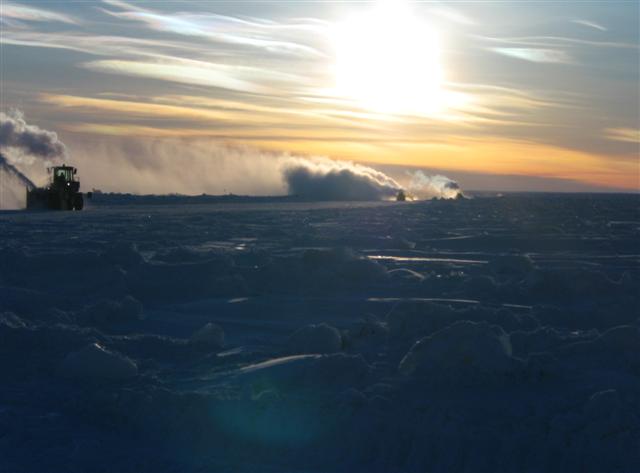
Photo Credit: Martin Reed/Antarctic Photo Library
Heavy equipment operators remove snow from the sea ice near McMurdo Station to help create a temporary airfield runway.
The Sea Ice Runway will be up and running for the first flights of the main summer field season and will stay in place until late December, when warm temperatures necessitate a move back to Pegasus for the remainder of the season. The two-month temporary move to an airfield closer to town saves countless man-hours in both commute times as well as maintenance and repair time on vehicles. Recreational activities have ramped with the influx of new people. The Coffee House has officially opened for summer, offering residents another venue for social gathering, movie nights and open mic presentations. Southern Exposure, formerly a smoking facility, is currently receiving a total remodel and will join the Coffee House and Gallagher’s as a social gathering place in early October. Other recreational activities under way for Winfly include sports tournaments, instructional clinics for the climbing wall, science lectures, rugby practice, and an arts and crafts fair to highlight the many talents on station. The main summer season will begin Sept. 29. At that time, winter-over personnel will begin their trips north and say their goodbyes, heading to adventures beyond the confines of Ross Island, this writer included. And though goodbyes can be sad, the promise of green grass, singing birds and fresh food keep our spirits high. Having given our best efforts over the winter, we can proudly hand over the reigns to a more energetic crew with no regrets. Have a great summer! McMurdo prepares to receive five August flightsPosted August 14, 2009
Things are ramping up at McMurdo Station 
Photo Credit: Bill Henriksen/Antarctic Photo Library
A U.S. Air Force C-17 lands at Pegasus airfield during a special night mission in 2008. Another traning mission is scheduled for this year's Winfly.
In an inter-departmental push, the Pegasus White Ice Runway In order to accommodate the influx of new people on station, McMurdo winter-overs are working hard to re-open buildings and expand workspaces. Dormitories left “cold” during the winter are being warmed up, and the current residents are shuffling their accommodations to make room for roommates. This year all but two dormitories will be needed to house the larger-than-normal Winfly population. The extra people will include more firefighters who are coming in to complete department training on the Ice, more scientists, and personnel for the South Pole Traverse who need to get a jumpstart on their season. Those extra people also necessitate the arrival of additional kitchen and janitorial staff to support the population. While we winter-overs do not relish the expanding population, we eagerly await the arrival of fresh fruits and vegetables (“freshies”) and mail from home. The approaching summer also means our thoughts turn to plans off the Ice. Tuesday nights have been scheduled for travelogues in the dining hall, as people share photos and stories of past travel adventures, and inspire new ones. McMurdo residents enjoy a little Midwinter revelryPosted July 2, 2009
A season of celebration has begun at McMurdo Station The Midwinter Dinner, marking the winter solstice and the shortest day of the year in the southern hemisphere, took place this year on Saturday, June 20. A unique and historic holiday for Antarctic winter-overs, it marks the beginning of the sun’s return to the horizon and the halfway point for the winter season. We celebrated in fine fashion this year, with a lavish dinner of beef tenderloin, duck and seafood-stuffed fish filets. Working with ingredients made up of mostly frozen and canned items, the cooks put together a remarkable meal, showcasing the talents of each member of the team. Fresh lettuce and cucumbers from the greenhouse were the pièce de résistance of this fine event. This year’s theme of the evening was “Remembering Antarctica of the Past,” and volunteers pitched in to transform the dining hall into a high-class venue resembling a museum, decorated with sepia-toned photos of expeditions past and historical items from polar exploration. The evening ended with speeches and greetings from station management, along with a dance highlighting music from all the nations currently living and working around Antarctica. Midwinter excitement continued the following weekend with the traditional midwinter run. This foot race, beginning in the center of town, follows a route out along the island’s peninsula and around Scott’s Hut before finishing outside the aerobics gym, where snacks and warm beverages awaited. This year’s race attracted about 75 runners, walkers and sprinters — nearly half of the station’s population. The revelry will continue on the Fourth of July weekend with the annual Independence Day carnival. Held in the large garage, the vehicle maintenance facility (VMF), the party will include games of skill and chance, a dunk tank, a barbeque and live music presented by the many talented musicians on station. The following day, the VMF folks will host the last indoor horseshoe competition of the winter season. All of this entertainment comes before the final push toward the Winfly season. This short preparatory period will begin with the first plane arriving at station on Aug. 20. The Winfly season is a time of flurried preparations to ready the station for the busy summer science season, which starts in early October. This year’s Winfly will expand the station population from the current 157 people to more 500, so the winter residents have a lot to do once the celebration ends to get ready for this onslaught of activity and new arrivals. Special projects keep McMurdo crew busyPosted June 5, 2009
Stormy weather obscured the final sunset on April 23 and since then McMurdo Station With the onset of total darkness, the residents of Ross Island have settled into a comfortable routine, both at work and at play. Daily tasking is being completed, along with some special projects, and a regular schedule of recreational activities keeps people entertained during non-working hours. After the excitement of some harsh, early winter storms, a bout of unseasonably warm weather and calm conditions has made working outdoors a much more pleasant experience. This has been a welcome change for several groups on station working on special projects that requires them to be outdoors a majority of the time. 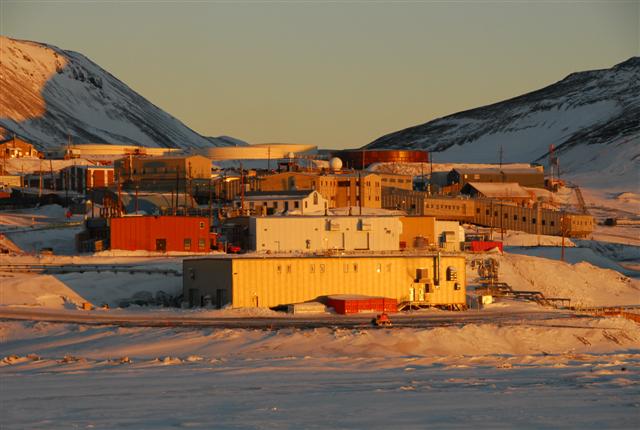
Photo Credit: Robyn Waserman/Antarctic Photo Library
The McMurdo power plant is the reddish building to the far left.
One of this winter’s special projects is the power plant upgrade project that will renovate and upgrade the old power plant building to house new generation equipment to power McMurdo. Currently, the station runs on generators that will serve as the backup power plant once the upgrade is complete. Even with the disruption from last month’s storms, the upgrade project is ahead of schedule and the new generators should be in place before the summer season. Another project nearing completion is the mapping of the entire heat trace system on station. Heat trace is an electrical heating component that runs alongside the water pipes throughout station to keep the water supply from freezing. Mapping and cataloguing the system for replacement and upgrade required weeks of leg work and arm work for the small group responsible for the project, as each section had to be physically traced and every joint dug out and visually inspected. This was no small task given the amount of snow and ice that surrounded much of the system. Other special projects include the fortification of the sea ice transition, the creation of an ice runway near station, and cleanup of the treatment trains at the wastewater treatment plant. A-Frame lostResidents of McMurdo Station bowed their heads alongside those at New Zealand’s Scott Base The fire occurred during a routine inspection by Scott Base personnel, who were completing a changeover of diesel fuel tanks, which heated the hut, according to a press release from Antarctica New Zealand 
Photo Credit: Timothy Russer/Antarctic Photo Library
Scott Base is located only a few miles from McMurdo Station.
The A-Frame was originally used on the ice wharf at McMurdo Station. However, when the U.S. Antarctic Program (USAP) During the winter, the Kiwis generously shared time and resources with McMurdo residents, allowing groups of people to retreat to the hut for overnight visits once a month. It will be missed as both a winter retreat and a historic icon of Antarctica’s past. The A-Frame was not the only way in which residents of McMurdo Station and Scott Base cooperate. Relations are close physically, with the research stations separated by only three miles, as well as emotionally, with residents sharing pastime activities and weekly meals together. Wednesday evenings are “American Night” at Scott Base, when USAP participants join their Kiwi counterparts for dinner and drinks in their galley and lounge. The Kiwis join in McMurdo recreational activities such as bingo and trivia nights. And social events such as the Famous Dead People’s Ball and Mid-winter Dinner celebration become all-island events as residents of both stations join together in the camaraderie of the shared winter. Storm packs big punch at McMurdoPosted April 24, 2009
As the final sunset approaches, winter has settled definitively on McMurdo Station The storm, appearing on weather radar to be a circular pattern similar to a hurricane, was typical for the changing seasons at this time of year. The storm was caused by a deep area of low pressure circulating in the Southern Ocean moving in a southerly direction toward the Ross Ice Shelf, according to Ed Saul, a weather observer working at McMurdo for the winter. 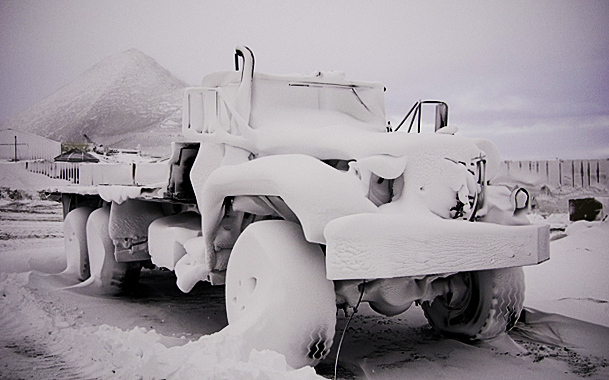
Photo Credit: Wally "James" Walker
Snow blankets a truck in McMurdo after a storm dumped 17.5 inches on the station over Easter weekend.
When this warmer northern air meets the cold air moving up from the south, an unstable low-pressure system forms and storms occur. This most often takes place during the months between summer and winter — in the spring and in the fall. This most recent storm was certainly more severe than anything recorded in recent times. A total of 17.5 inches fell over the course of the storm, with a record 14 inches coming during one 24-hour period, breaking the long-standing record of 10 inches set in April 1968. This heavy snowfall, combined with winds peaking at 78 knots, or approximately 90 miles per hour, caused long periods of almost zero visibility and immense snowdrifts throughout McMurdo. Saul explained that even with the high winds blowing snow in every direction, the measurement of total accumulation is quite accurate due to a specially designed collection system with a bell-shaped cover to separate out blowing snow from the true fallen snow. Collected snow is then melted and measured as liquid with a special conversion chart. After hunkering down to weather the storm over an unexpected two-day weekend, the station residents came out in force to dig out and resume normal daily life around town. The digging-out process was an event in itself, as doorways, vehicles and even the interiors of several buildings needed to be cleared of snow, often piled 6 to 8 feet high. An initial damage assessment showed there to be minimal serious damage, although flying debris did break several windows and vehicle windshields. The stormy conditions added an extra level of excitement to an already eventful Easter weekend. Residents awoke on Sunday morning to discover that the Easter Bunny had left baskets of goodies — including dyed eggs, candy, and Easter bunny-shaped cookies for every person on station. A day of feasting to match the holiday followed. The dining hall staff outdid itself with a brunch including homemade filled doughnuts, platters of smoked salmon, cheese plates, and miniature quiches, along with eggs made to order and a buffet of other scrumptious breakfast items. Dinner included the traditional spiral ham, a delicious seafood stew and was topped off with homemade truffles decorated in Easter colors by the station’s talented bakery chef. It was an excellent way to celebrate the holiday far from friends and family. McMurdo Station enters winter with 153 peoplePosted March 16, 2009
The last flight of the summer season left McMurdo Station 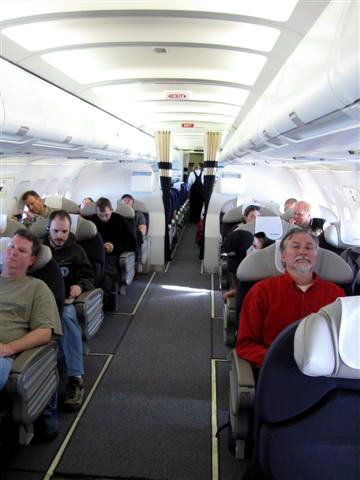
Photo Credit: Nick Powell/Antarctic Photo Library
USAP participants enjoy a comfortable ride on an Australian Airbus. The program used some commercial flights in lieu of military aircraft this season to move people on and off the Ice.
The signs of winter are already creeping over the station, bringing shorter days and a layer of snow that is a welcome change from the dusty, dry days of summer. The open water, cleared by a mild summer and the arrival of the shipping vessel in February, began freezing over shortly after the Australian Airbus carrying the last summer employees disappeared over Mount Erebus, but not before two tourist cruise ships paid a visit. The Marina Svetaeva, a Russian cruise ship sailing out of Hobart, Australia, shuttled passengers ashore on Feb. 16 on its helicopter. Strong winds and choppy seas kept the passengers from the Spirit of Enderby, out of New Zealand, from making it to McMurdo on Feb. 25. But we had some late season visitors in the shape of emperor and Adélie penguins, skuas and a bevy of Weddell seals. The winter-over residents at McMurdo have been busy planning the many activities that will keep them busy during the winter. Unfortunately, one of the station’s recreation buildings, constructed in 1958, was closed over the summer due to structural issues, leaving residents with a few less options, but the creative crew is making due and coming up with new ways to pass the time. Participation in activities at the Big Gym is up, with a strong showing from the residents of New Zealand’s Scott Base 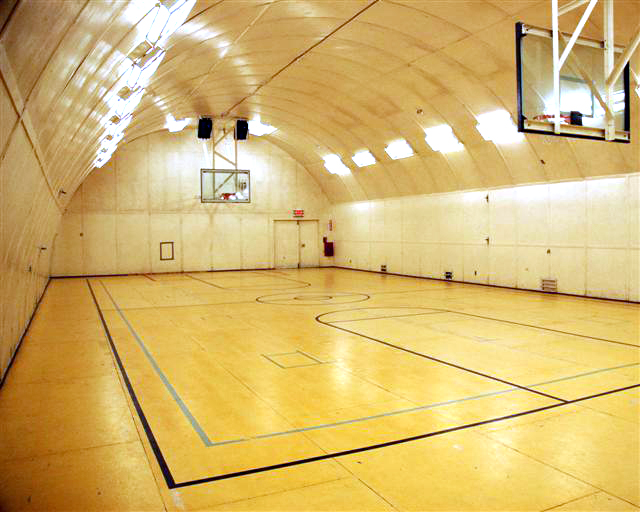
Photo Credit: Timothy Russer/Antarctic Photo Library
The Big Gym at McMurdo Station is popular for team sports like indoor soccer, dodgeball and basketball.
Some of the other off-duty activities include movie nights, featuring weekly science movies focused on Antarctic history and research; musicians putting bands together for the winter music scene; and a photo club for budding and experienced photographers to share their knowledge on how to capture the beauty of the dark Antarctic night. The first two-day weekend of the winter season featured a burger bar at Gallagher’s Pub, with volunteer cooks offering free burgers and fries to patrons. The women of McMurdo Station and Scott Base also joined forces for the first women’s social to meet and greet the other females of the Deep South. The gathering, attended by most of McMurdo’s 37 women and Scott Base’s seven females, was an opportunity for all who attended to learn more about one another and share stories. In the mix were women ranging in age from 25 to 59, with newcomers experiencing their first season on the Ice and others who have spent more than 21 years supporting McMurdo Station. The Employee Safety Committee recently met for its first winter meeting to elect officers and pave the way for a safe season. The committee works throughout the year to help ensure employee safety both on and off the job, and have already begun planning events to promote a safer and healthier winter. March 16-20 was designated as “Clean Your Work Center for Winter Week” to encourage employees to maintain safe work areas, and a program is in place to acknowledge and reward those employees who go above and beyond to help ensure a safe season. Winter-over employees have to be especially diligent about safety issues, as working conditions deteriorate with winter weather and the onset of darkness — not to mention the limited medical facilities and the risks of a mid-winter medical evacuation. Employees don’t have long to wait for the dark night, as just around the corner is the final sunset on April 23. McMurdo Station going full tilt at mid-seasonPosted December 19, 2008
McMurdo Station The Oden, a Swedish icebreaker contracted for this season, is on its way here and should reach the edge of the sea ice at the beginning of January. Tour guides have been trained in anticipation of any tourist ships that might make their way to McMurdo for a visit. 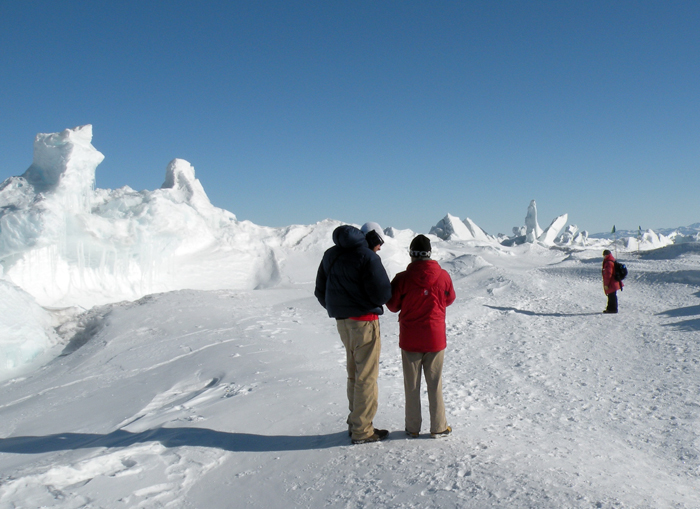
Photo Credit: Robert Lewis Jr.
People from McMurdo Station explore pressure ridges near New Zealand's Scott Base.
Thanksgiving weekend brought with it our first real storm of the austral summer, and while flights were delayed, keeping fresh vegetables and fruit from arriving in time, the meal was still beautifully executed by the food services crew. Over the months of October and November, recreation volunteers conducted 26 trips with more than 450 people to see nearby ice caves, and many of those travelled on to Cape Evans as well. This was a big morale boost in the community, and the volunteers continue to work hard to provide opportunities to McMurdo’s residents, now refocusing their time and efforts on trips through the pressure ridges near New Zealand’s Scott Base The 13th Annual Women’s Soiree was held on December 13th, providing an evening of entertainment for the community. The theme for the evening, “A Night With Old Hollywood,” brought about a dazzling transformation of the dining hall into a red carpet event showcasing the talents of many McMurdo ladies. The Long Duration Balloon project The most recent science lecture presented by a group from The Exploratorium The middle of the season also brings with it the holidays and preparation for the Town Holiday Party. Volunteers all over station are busy preparing to bring Christmas magic to the community on Christmas Eve. The Holiday Choir began practicing a couple weeks ago and will be singing to field camps near and far on Christmas Day. The U.S. Air Force C-17 has ended its mainbody opening support and will return for the season close-out in mid-January. In the interim, South Africa, Australia and New Zealand planes will handle intercontinental flights. As we head toward the New Year, we can refelct on all we've accomplished, and the rest yet to come for this summer season. After all, we still have two more months left until winter. Ice caves are back after seven-year hiatusPosted November 14, 2008
It’s been seven years since the residents of McMurdo Station The “caves” are not really caves per say, but instead are crevasses that are covered by snow bridges with a re-frozen seawater floor. The Erebus Glacier had been held back from surging at a steady pace toward the sea by the frozen sea ice surrounding it. This increasingly built up the potential energy of the glacier tongue. Finally, this past season, when the sea ice edge started to recede south toward the glacier tongue, the energy was released and the glacier surged forward, causing large chunks of glacier ice to break off the edge of the tongue. Once the movement had settled, the tip of the Erebus Glacier Tongue was left as the vertical blue wall of ice that can now be seen. A small portion of the edge folded forward to create the crevasse that is now accessible to enter. Tours of the cave, taken during off-hours for personnel, have begun again. Joanna Schwartz, one of the trip leaders says, “A lot of people enter the cave and say, ‘This is so incredible.’ They’re so happy to have had the opportunity to experience something so amazing. Someone on my trip yesterday slid down into the entrance of the cave and sat there staring. I asked him if he needed help up, but he just continued to look around in awe.” Visitors enter the cave by sliding down a slope into the cave, which is walled by the actual glacier. Along the entrance to and inside the cave, there are ice crystals, ice stalactites, and varied shades of blue light filtering through the ice and snow bridge overhead. A tremendous amount of effort from volunteers in the community has allowed more than 150 people to visit the cave already, and more trips are scheduled. Volunteers are required to attend several different trainings to be able to conduct the trips, as well as volunteer their free time to lead excursions for the community. The reward for the volunteers seems to come from seeing smiles and hearing the thanks from the participants on the trips. “For me, all the hard work and long hours are totally worth it when you see all the smiles and how happy it makes people,” said Jean Scheaffer, one of the coordinators for the recreation trips. “Someone told me last week after a trip, ‘Now I feel like I’m in Antarctica,’ and it’s comments like that that stick in my head.” Today Show Part DeuxThe Today Show is headed back to Antarctica. Sort of. The morning news show will interview scientist Stacy Kim from McMurdo Station remotely for an episode scheduled to appear Nov. 18. Kim and her team are testing a new submersible for exploring the benthic ecosystem under the sea ice in McMurdo Sound. [See related story: Fitting in.] McMurdo welcomes first crew members of new seasonPosted September 26, 2008
Times — they are a changin’. The sun has risen at McMurdo Station, stretching the daylight hours to more than 13 each day. Lines have formed in the dining hall, and the wait for freshly cooked eggs at Sunday brunch has lengthened. Rooms that served as comfortable single units now make way for roommates. SpringFly has come to McMurdo. Formerly called WinFly (for winter fly-in), this is the time between sunrise and the onset of the main summer season. Historically, Winfly was a six-week period of slightly increased staffing brought in to assist the winter-over staff in preparing for the hustle and bustle of the coming field season. The extra staff assists in opening buildings that have been dormant for the winter, bringing up the full fleet of summer vehicles and equipment, and preparing supplies and materials for the science groups anxiously waiting their time to deploy to Antarctica. This year, the tasking is the same, but the period of time designated for this ramping up is now less than four weeks. The five SpringFly flights accomplished a lot, in not only the movement of people, but also the transportation of essential goods both on and off the continent. While a small group of winter-overs completed their contracts and headed north to warmer climes, the majority stayed on to assist in the station preparations. About 250 fresh new staffers joined the winter-overs, bringing the population to 320 people — almost triple the population of the winter season. These new staff members have primarily filled positions in stations support such as the dining hall, maintenance shops and vehicle repair, as well as science support roles preparing for the onslaught of summer science. A few members of science research teams arrived to check on ongoing research projects, and the members of the South Pole Traverse all deployed to get a jump-start on their long overland journey to the South Pole and a deep-field science camp, Antactic Gamburtsev Province, in East Antarctica to deliver fuel and cargo this season. Along with this new and energetic bunch, the inbound flights brought essential cargo and materials to support both science and the high-profile traverse project. More importantly, at least for those at the tail end of their eight-month winter, the flights also brought mail and fresh produce. More than 10,000 pounds of cargo were dedicated to the delivery of long-awaited packages, including gifts and letters from home, essential items like toiletries and medications, and brand new toys. The 3,072 pounds of freshies included a variety of fruits and vegetables that have spiced up the already wonderful offerings of the dining staff. The appearance of the postal clerk also meant that gifts and packages could be sent out, allowing many to begin packing and shipping their extra items in preparation for the post-winter exodus. In all, the flights transported 299 passengers and 300,000 pounds of cargo over the span of one week. After the excitement of a busy week of tearful good byes, joyful reunions, hectic transports and busy skies, there is no rest for the weary. The short SpringFly season will end on Sept. 30, less than a month after it began, with the arrival of the first of many mainbody flights. These flights will bring in scientists and the many extra support staff needed to run a station of almost 1,100 summer residents — and in those few short weeks, those who are here will be hard at work priming the station for their arrival. |
Home /
Around the Continent /
McMurdo Station Archives
"News about the USAP, the Ice, and the People"



For USAP Participants |
For The Public |
For Researchers and EducatorsContact UsNational Science FoundationOffice of Polar Programs Geosciences Directorate 2415 Eisenhower Avenue, Suite W7100 Alexandria, VA 22314 Sign up for the NSF Office of Polar Programs newsletter and events. Feedback Form |


